Summit Data Communications SDCMSD40NBT 802.11abgn (1X1) + Bluetooth (2.1) module User Manual MSD40NBT Hardware Integration Guide v 02
Summit Data Communications, Inc. 802.11abgn (1X1) + Bluetooth (2.1) module MSD40NBT Hardware Integration Guide v 02
Contents
- 1. User Manual
- 2. user manual
- 3. user manual I
- 4. user manual II
User Manual

Summit Data Communications, Inc., 526 South Main Street Suite 805 Akron, OH 44311
Tel: 866-434-4300 www.summitdatacom.com
© 2011 – 2012 Summit Data Communications, Inc. All rights reserved.
SDC-MSD40NBT
User’s Guide
Version 1.0

User’s Guide – SDC-MSD40NBT
2
SDC-MSD40NBT_UsersGuide
© 2011 – 2012 Summit Data Communications, Inc. All rights reserved.
Contents
Contents ........................................................................................................................................................ 2
Scope ............................................................................................................................................................. 3
Operational Description ................................................................................................................................ 3
Specifications ................................................................................................................................................ 4
Recommended Operating Conditions and DC Electrical Characteristics .................................................... 10
SDIO Timing Requirements ................................................................................................................. 11
UART Timing Requirements ................................................................................................................ 12
PCM Interface Timing .......................................................................................................................... 12
Pin Definitions ............................................................................................................................................. 17
Control Signal Timing Diagrams .......................................................................................................... 21
MSD30AG and MSD40NBT Pin Comparison Table ................................................................................. 22
Integration Considerations ..................................................................................................................... 23
Mechanical Specifications ........................................................................................................................... 24
Connector Overview ............................................................................................................................... 24
MSD40NBT Attached to T-Board ........................................................................................................ 24
Mounting................................................................................................................................................. 25
RF Layout Design Guidelines ....................................................................................................................... 25
Regulatory ................................................................................................................................................... 26
Certified Antennas .................................................................................................................................. 26
Documentation Requirements ............................................................................................................... 26
FCC ...................................................................................................................................................... 26
Industry Canada .................................................................................................................................. 27
European Union .................................................................................................................................. 29
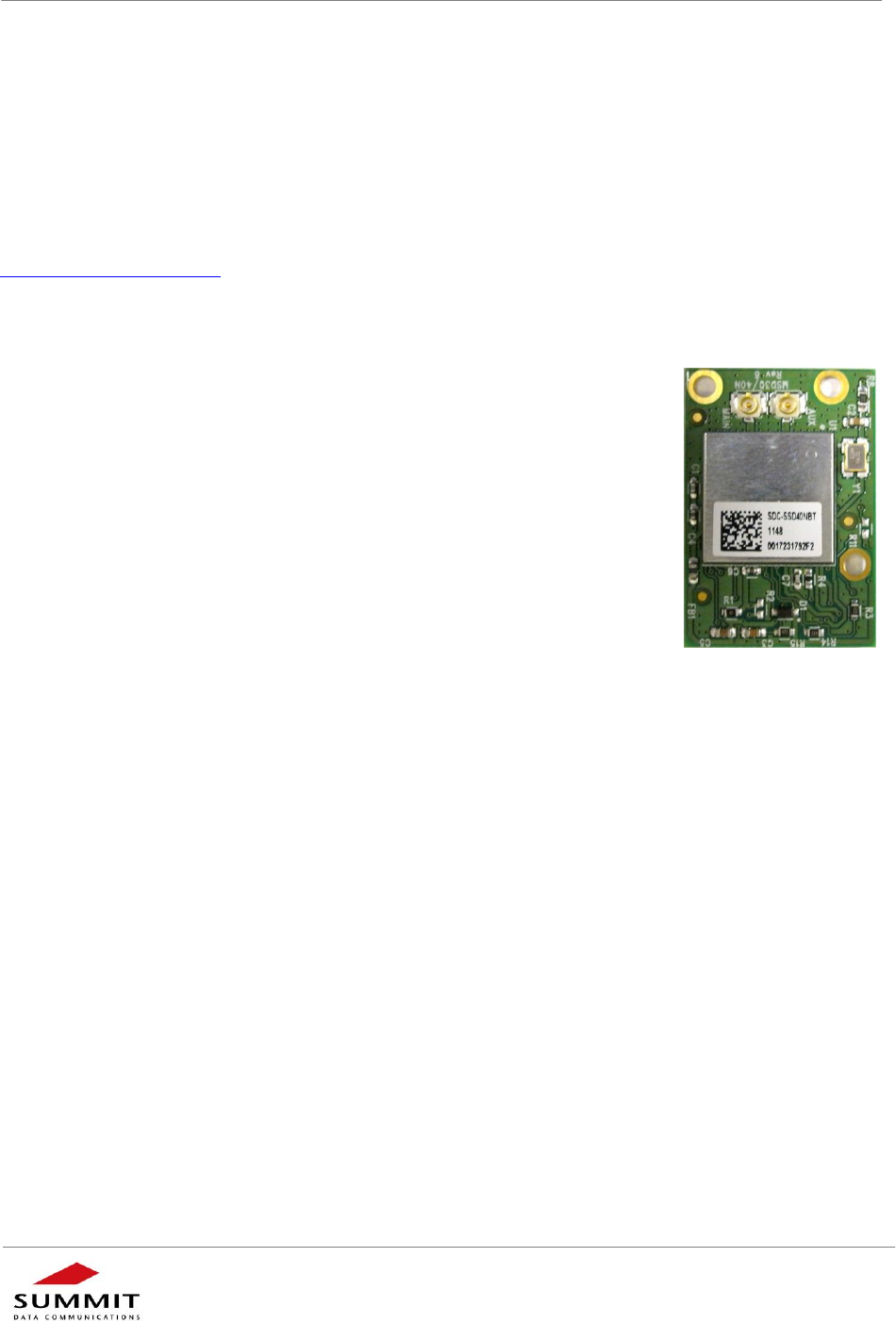
User’s Guide – SDC-MSD40NBT
3
SDC-MSD40NBT_UsersGuide
© 2011 – 2012 Summit Data Communications, Inc. All rights reserved.
Scope
This document describes key hardware aspects of the Summit SDC-MSD40NBT radio module. This
document is intended to assist device manufacturers and related parties with the integration of this radio
into their host devices. Data in this document is drawn from a number of sources and includes information
found in the Broadcom BCM4329 data sheet issued in June of 2009.
The SDC-MSD40NBT is currently in pre-production and this document is preliminary. The information in
this document is subject to change. Please contact Summit or visit the Summit website at
www.summitdatacom.com to obtain the most recent version of this document.
Operational Description
This device is an SDC-MSD40NBT radio module which supports IEEE
802.11a/b/g/n standards via an SDIO (Secure Digital Input/Output) interface
and Bluetooth version 2.1 via a serial UART (Universal Asynchronous
Receiver/Transmitter) interface. The radio operates in unlicensed portions of
the 2.4 GHz and 5 GHz radio frequency spectrum. The device is compliant with
IEEE 802.11a, 802.11b, 802.11g, and 802.11n standards using Direct
Sequence Spread Spectrum (DSSS) and Orthogonal Frequency Division
Multiplexing (OFDM), and supports Bluetooth 2.1 using Frequency Hopping
Spread Spectrum (FHSS). The device supports all 802.11a, 802.11b, 802.11g,
802.11n, and Bluetooth data rates and automatically adjusts data rates and
operational modes based on various environmental factors.
When operating on channels in the UNII-2 and UNII-2 Extended bands that are
in the 5GHz portion of the frequency spectrum and are subject to Dynamic Frequency Selection
requirements, the SDC-MSD40NBT fully conforms to applicable regulatory requirements. In the event that
specified types of radar are detected by the network infrastructure, the SDC-MSD40NBT fully conforms to
commands from the infrastructure for radar avoidance.
The SDC-MSD40NBT interfaces to host devices via a 60-pin connector. The device is based on the
Broadcom BCM4329chip which is an integrated device providing a Media Access Controller (MAC), a
Physical Layer Controller (PHY or baseband processor), and fully integrated dual-band radio transceiver.
To maximize operational range, the SDC-MSD40NBT incorporates a 5 GHz power amplifier (PA) to
increase transmit power. The frequency stability for both 2.4 GHz (802.11b and 802.11g) and 5 GHz
(802.11a) operation is +/- 20 ppm.
The SDC-MSD40NBT has its own RF shielding and does not require shielding provided by the host
device into which it is installed in order to maintain compliance with applicable regulatory standards. As
such, the device may be tested in a standalone configuration via an extender card.
The device buffers all data inputs so that it will comply with all applicable regulations even in the presence
of over-modulated input from the host device. Similarly, the SDC-SSD40NBT incorporates power
regulation to comply with all applicable regulations even when receiving excess power from the host
device.
The SDC-MSD40NBTprovides two unique U.FL type antenna connectors tosupport dual band transmit
and receive diversity. Supported host device antenna types include dipole and monopole antennas.

User’s Guide – SDC-MSD40NBT
4
SDC-MSD40NBT_UsersGuide
© 2011 – 2012 Summit Data Communications, Inc. All rights reserved.
Regulatory operational requirements are included with this document and may be incorporated into the
operating manual of any device into which the SDC-MSD40NBT is installed. The SDC-MSD40NBT is
designed for installation into mobile devices such as vehicle mount data terminals (which typically operate
at distances greater than 20 cm from the human body) and portable devices such as handheld data
terminals (which typically operate at distances less than 20 cm from the human body). See
“Documentation Requirements” for more information.
Specifications
Feature
Description
Physical Interface
Molex 54722-0607 60-pin connector (mates to Molex 55560-0607
60-pin connector)
Wi-Fi Interface
1-bit or 4-bit Secure Digital I/O
Bluetooth Interface
Host Controller Interface (HCI) using High Speed UART
Antenna Interface
2 Hirose U.FL connectors for dual-band antenna diversity
IMPORTANT:
When using a single antenna,
it MUST be connected to the Auxiliary (AUX) port.
BT functions on the AUX port and not the Main port.
For WiFi/BT single-antenna implementations,
the AUX port must be used.
Main Chip
Broadcom BCM4329
Input Voltage Requirements
3.3 VDC ± 10% (core)
I/O Signaling Voltage
3.3 VDC ± 10%
Average Current Consumption,
VDDIO = 3.3 volts
(At maximum transmit power
setting)
Note: Standby refers to the radio
operating in PM1
powersave mode.
802.11a (with BT in standby)
Transmit: 282 mA (931 mW)
Receive: 92 mA (304 mW)
Standby: TBD
802.11b (with BT in standby)
Transmit: 314 mA (1036 mW)
Receive: 92 mA (304 mW)
Standby: TBD
802.11g (with BT in standby)
Transmit: 288 mA (950 mW)
Receive: 92 mA (304 mW)
Standby: TBD
802.11n (2.4 GHz) (with BT in standby)
Transmit: 292 mA (964 mW)
Receive: 92 mA (304 mW)
Standby: TBD
802.11n (5 GHz) (with BT in standby)
Transmit: 270 mA (891 mW)
Receive: 92 mA (304 mW)
Standby: TBD

User’s Guide – SDC-MSD40NBT
5
SDC-MSD40NBT_UsersGuide
© 2011 – 2012 Summit Data Communications, Inc. All rights reserved.
Feature
Description
Bluetooth (with Wi-Fi in standby)
Transmit: TBD mA (TBD mW)
Receive: TBD mA (TBD mW)
Operating Temperature
-25° to 80°C (-13° to 176°F)
Operating Humidity
10 to 90% (non-condensing)
Storage Temperature
-25° to 85°C (-13° to 185°F)
Storage Humidity
10 to 90% (non-condensing)
Maximum Electrostatic
Discharge
8 kV
Length
32 mm (1.26 in.)
Width
22 mm (0.87 in.)
Thickness
5.05mm (0.17 in.)
Weight
3.0 g (0.11 oz.)
Mounting
60-pin connector, mounting holes (M2 screws)
Wi-Fi Media
Direct Sequence-Spread Spectrum (DSSS)
Complementary Code Keying (CCK)
Orthogonal Frequency Divisional Multiplexing (OFDM)
Bluetooth Media
Frequency Hopping Spread Spectrum (FSSS)
Wi-Fi Media Access Protocol
Carrier sense multiple access with collision avoidance
(CSMA/CA)
Network Architecture Types
Infrastructure and ad hoc
Wi-Fi Standards
IEEE 802.11a, 802.11b, 802.11d, 802.11e, 802.11g, 802.11h,
802.11i, 802.11n
Bluetooth Standards
Bluetooth version 2.1 with Enhanced Data Rate
Wi-Fi Data Rates Supported
802.11a (OFDM) 6, 9, 12, 18, 24, 36, 48, 54 Mbps
802.11b (DSSS, CCK) 1, 2, 5.5, 11 Mbps
802.11g (OFDM) 6, 9, 12, 18, 24, 36, 48, 54 Mbps
802.11n (OFDM, MCS 0-7) 6.5, 7.2, 13.0, 14.4, 19.5, 21.7, 26.0,
28.9, 39.0, 43.3, 52.0, 57.8, 58.5, 65.0, 72.2 Mbps
Wi-Fi Modulation
BPSK @ 1, 6, 6.5, 7.2 and 9 Mbps
QPSK @ 2, 5.5, 11, 12, 13, 14.4,18, 19.5 and 21.7 Mbps
16-QAM @ 24, 26, 28.9, 36, 39 and 43.3 Mbps
64-QAM @ 48, 52, 54, 57.8, 58.5, 65, and 72.2 Mbps
802.11n Spatial Streams
1 (Single Input, Single Output)
Bluetooth Data Rates Supported
1, 2, 3 Mbps
Bluetooth Modulation
GFSK@ 1 Mbps
π/4-DQPSK@ 2 Mbps
8-DPSK@ 3 Mbps

User’s Guide – SDC-MSD40NBT
6
SDC-MSD40NBT_UsersGuide
© 2011 – 2012 Summit Data Communications, Inc. All rights reserved.
Feature
Description
Regulatory Domain Support
FCC (Americas, Parts of Asia, and Middle East)
ETSI (Europe, Middle East, Africa, and Parts of Asia)
MIC (Japan) (formerly TELEC)
KC (Korea) (formerly KCC)
Wi-Fi and Bluetooth 2.4 GHz
Frequency Bands
ETSI
2.4 GHz to 2.483 GHz
FCC
2.4 GHz to 2.483 GHz
MIC (Japan)
2.4 GHz to 2.495 GHz
KC
2.4 GHz to 2.483 GHz
Wi-Fi 5 GHz Frequency Bands
ETSI
5.15 GHz to 5.35 GHz
5.47 GHz to 5.725 GHz
FCC
5.15 GHz to 5.35 GHz
5.725 GHz to 5.82 GHz
MIC (Japan)
5.15 GHz to 5.35 GHz
KC
5.15 GHz to 5.35 GHz
5.47 GHz to 5.725 GHz
5.725 GHz to 5.82 GHz
Wi-Fi 2.4 GHz Operating
Channels
ETSI: 13 (3 non-overlapping)
FCC: 11 (3 non-overlapping)
MIC (Japan): 14 (4 non-overlapping)
KCC: 13 (3 non-overlapping)
Wi-Fi 5 GHz Operating Channels
ETSI: 19 non-overlapping
FCC: 23 non-overlapping
MIC (Japan): 8 non-overlapping
KCC: 23 non-overlapping

User’s Guide – SDC-MSD40NBT
7
SDC-MSD40NBT_UsersGuide
© 2011 – 2012 Summit Data Communications, Inc. All rights reserved.
Feature
Description
Transmit Power
Note: Transmit power varies
according to individual country
regulations. All values nominal, +/-
2 dBm.
Note: Summit 40 series radios
support a single spatial stream and
20 MHz channels only.
802.11a
6 Mbps
16 dBm (40 mW)
54 Mbps
16 dBm (40 mW)
802.11b
1 Mbps
16 dBm (40 mW)
11 Mbps
16 dBm (40 mW)
802.11g
6 Mbps
15 dBm (32 mW)
54 Mbps
14 dBm (25 mW)
802.11n (2.4 GHz)
6.5 Mbps (MCS0)
13 dBm (20 mW)
65 Mbps (MCS7)
11 dBm (13 mW)
802.11n (5 GHz)
6.5 Mbps (MCS0)
16 dBm (40 mW)
65 Mbps (MCS7)
13 dBm (20 mW)
Bluetooth
1 Mbps
-0.5 dBm (1.1 mW)
2 Mbps
-0.5 dBm (1.1 mW)
3 Mbps
-0.5 dBm (1.1 mW)
Typical Receiver Sensitivity
Note: All values nominal, +/-3
dBm.
802.11a:
6 Mbps
-89 dBm
54 Mbps
-77 dBm (PER <= 10%)
802.11b:
1 Mbps
-95 dBm
11 Mbps
-87 dBm (PER <= 8%)
802.11g:
6 Mbps
-90 dBm
54 Mbps
-77 dBm (PER <= 10%)
802.11n (2.4 GHz)
MCS0 Mbps
-90 dBm
MCS7 Mbps
-73 dBm
802.11n (5 GHz)
MCS0 Mbps
MCS7 Mbps
-88 dBm
-71 dBm
Bluetooth:
1 Mbps
TBD
2 Mbps
TBD
3 Mbps
TBD

User’s Guide – SDC-MSD40NBT
8
SDC-MSD40NBT_UsersGuide
© 2011 – 2012 Summit Data Communications, Inc. All rights reserved.
Feature
Description
Operating Systems Supported
Windows Mobile 6.5
Windows Mobile 6.1
Windows Mobile 6.0
Windows Mobile 5.0
Windows Embedded CE 7.0
Windows Embedded CE 6.0 R3
Windows Embedded CE 6.0 R2
Windows Embedded CE 6.0
Windows Embedded CE 5.0
Linux, 2.6.x, 3.x.x kernel
Security
Standards
Wireless Equivalent Privacy (WEP)
Wi-Fi Protected Access (WPA)
IEEE 802.11i (WPA2)
Encryption
Wireless Equivalent Privacy (WEP, RC4 Algorithm)
Temporal Key Integrity Protocol (TKIP, RC4 Algorithm)
Advanced Encryption Standard (AES, Rijndael Algorithm)
Encryption Key Provisioning
Static (40-bit and 128-bit lengths)
Pre-Shared (PSK)
Dynamic
802.1X Extensible Authentication Protocol Types
EAP-FAST
EAP-TLS
EAP-TTLS
PEAP-GTC
PEAP-MSCHAPv2
PEAP-TLS
LEAP
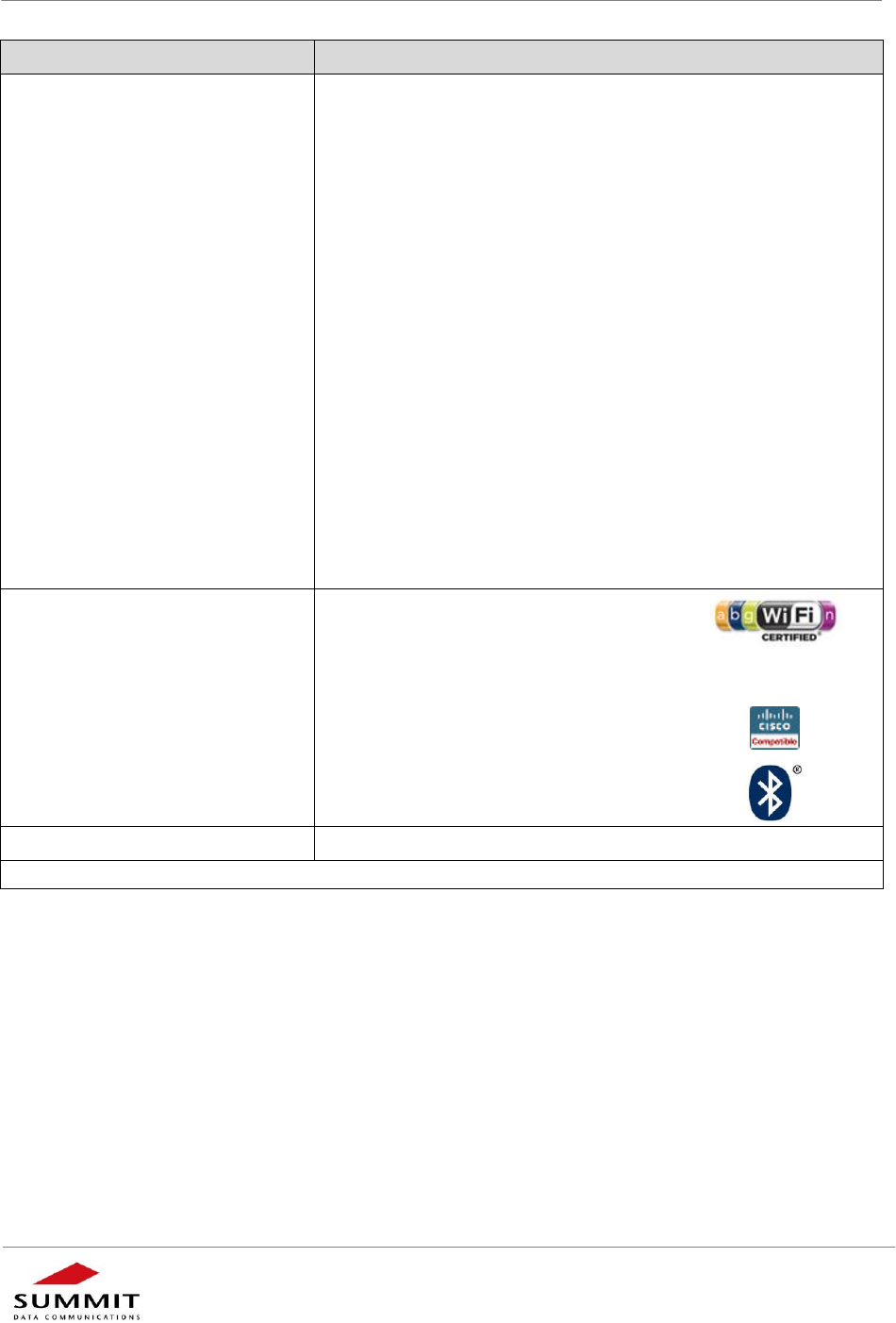
User’s Guide – SDC-MSD40NBT
9
SDC-MSD40NBT_UsersGuide
© 2011 – 2012 Summit Data Communications, Inc. All rights reserved.
Feature
Description
Compliance
Note: These agency approvals
are pending.
ETSI Regulatory Domain
EN 300 328
EN 300 328 v1.7.1 (BT 2.1)
EN 301 489-1
EN 301 489-17
EN 301 893
EN 60950-1
EU 2002/95/EC (RoHS)
FCC Regulatory Domain
FCC 15.247 DTS – 802.11b/g (Wi-Fi) – 2.4 GHz & 5.8 GHz
FCC 15.407 UNII – 802.11a (Wi-Fi) – 2.4 GHz & 5.4 GHz
FCC 15.247 DSS – BT 2.1
Industry Canada
RSS-210 – 802.11a/b/g/n (Wi-Fi) – 2.4 GHz, 5.8 GHz, 5.2 GHz,
and 5.4 GHz
RSS-210 – BT 2.1
MIC (Japan) Regulatory Domain (formerly TELEC)
Article 2 Item 19, Category WW (2.4GHz Channels 1-13)
Article 2 Item 19-2, Category GZ (2.4GHz Channel 14)
Article 2 Item 19-3 Category XW (5150-5250 W52 & 5250-5350
W53)
Article 2-1 Item 19-2 (BT 2.1)
Certifications
Note: These certifications are
pending.
Wi-Fi Alliance
802.11a, 802.11b, 802.11g , 802.11n
WPA Enterprise
WPA2 Enterprise
Cisco Compatible Extensions (Version 4)
Bluetooth SIG Qualification
Warranty
Limited Lifetime
All specifications are subject to change without notice
Table 1: Specifications

User’s Guide – SDC-MSD40NBT
10
SDC-MSD40NBT_UsersGuide
© 2011 – 2012 Summit Data Communications, Inc. All rights reserved.
Recommended Operating Conditions and DC Electrical Characteristics
Symbol
Parameter
Min.
Typ.
Max.
Unit
VCC
DC Supply Voltage
3.0
3.3
3.6
V
VDD_IO
DC Supply Voltage (I/O)
-1.8
-
-3.3
V
VIL
Low Level Input Voltage
(VDDO = 3.3V)
-
-
0.8
V
VIH
High Level Input
Voltage (VDDO = 3.3V)
2.0
-
-
V
VOL
Low Level Output
Voltage (100 µA load)
-
-
0.2
V
VOH
High Level Output
Voltage (-100 µA load)
VDDIO– 0.2V
-
-
V
IIL
Low Current Input
-
0.3
-
µA
IIH
High Current Input
-
0.3
-
µA
IOL
Low Current Output
(VDDO = 3.3V, VOL =
0.4V)
-
-
3.0
mA
IOH
High Current Output
(VDDO = 3.3V, VOH =
2.9V)
-
-
3.0
mA
CIN
Input Capacitance
-
-
5
pF
BT UART Baud Rate
9600 bps
115.2
Kbps
(default
coming out
of reset)
4 Mbps
bps/Kbps/Mbps
Table 2: Recommended Operating Conditions and DC Electrical Characteristics
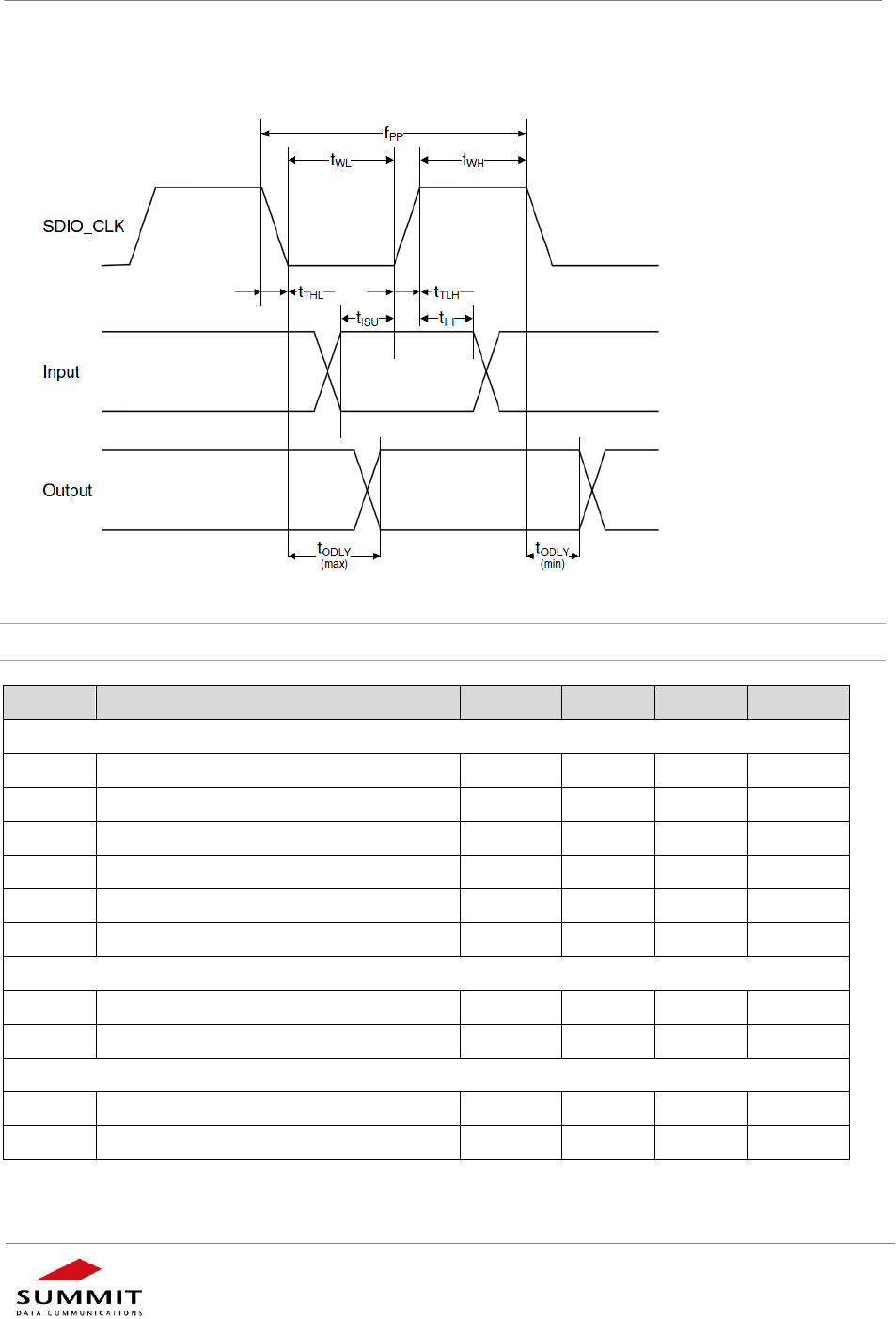
User’s Guide – SDC-MSD40NBT
11
SDC-MSD40NBT_UsersGuide
© 2011 – 2012 Summit Data Communications, Inc. All rights reserved.
SDIO Timing Requirements
The following figure (Figure 1) and table display SDIO default mode timing.
Figure 1: SDIO Default Mode Timing
Note: Timing is based on CL ≤ 40pF load on CMD and Data.
Symbol
Parameter
Min.
Typ.
Max.
Unit
SDIO CLK (All values are referred to minimum VIH and maximum VIL*)
fPP
Frequency – Data Transfer mode
0
-
25
MHz
fOD
Frequency – Identification mode
0
-
400
kHz
tWL
Clock low time
10
-
-
ns
tWH
Clock high time
10
-
-
ns
tTLH
Clock rise time
-
-
10
ns
tTHL
Clock low time
-
-
10
ns
Inputs: CMD, DAT (referenced to CLK)
tISU
Input setup time
5
-
-
ns
tIH
Input hold time
5
-
-
ns
Outputs: CMD, DAT (referenced to CLK)
tODLY
Output delay time – Data Transfer mode
0
-
14
ns
tODLY
Output delay time – Identification mode
0
-
50
ns
*min(Vih) = 0.7 x VDDIO and max(ViL) = 0.2 x VDDIO.
Table 3: SDIO Timing Requirements
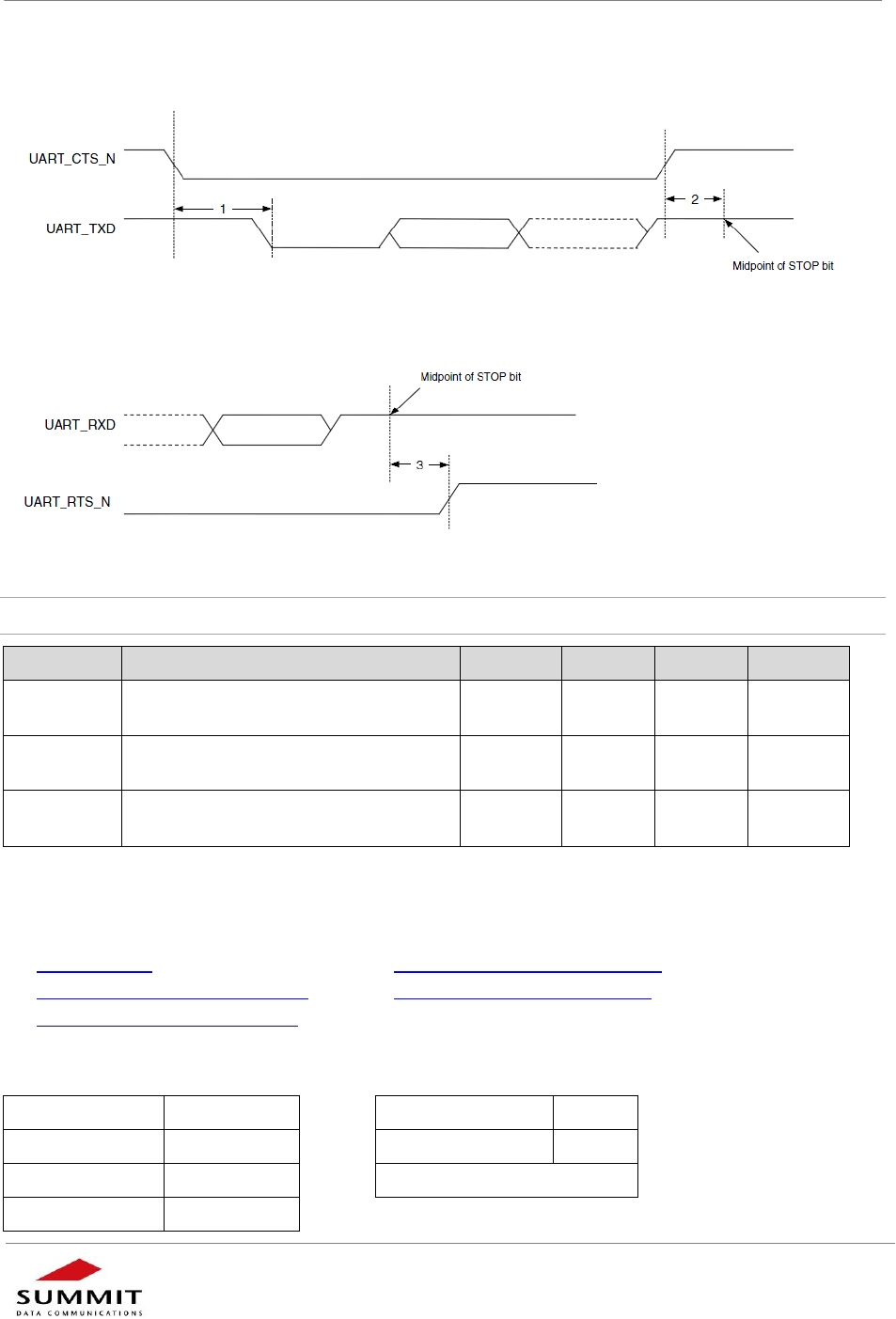
User’s Guide – SDC-MSD40NBT
12
SDC-MSD40NBT_UsersGuide
© 2011 – 2012 Summit Data Communications, Inc. All rights reserved.
UART Timing Requirements
The following figure (Figure 2) displays UART timing.
Figure 2: UART Timing Requirements
Notes: The UART 4-wire interface supports Bluetooth 2.1 HCI Specification.
Reference
Description
Min.
Typ.
Max.
Unit
1
Delay time, BT_UART_CTS_N low to
UART_TXD valid
-
-
24
Baudout
cycles
2
Setup time, BT_UART_CTShigh
before midpoint of stop bit
-
-
10
ns
3
Delay time, midpoint of stop bit to
BT_UART_RTS_N high
-
-
2
Baudout
cycles
Table 4: UART Timing Requirements
PCM Interface Timing
PCM Defaults
Short Frame Sync, Master Mode
Short Frame Sync, Slave Mode
Long Frame Sync, Master Mode
Long Frame Sync, Slave Mode
PCM Defaults
SCO Routing
PCM
Interface Rate
512
Clock Mode
Master
Sample Interval
8khz
Sync Mode
Master
16 bit mono
Frame Type
Short
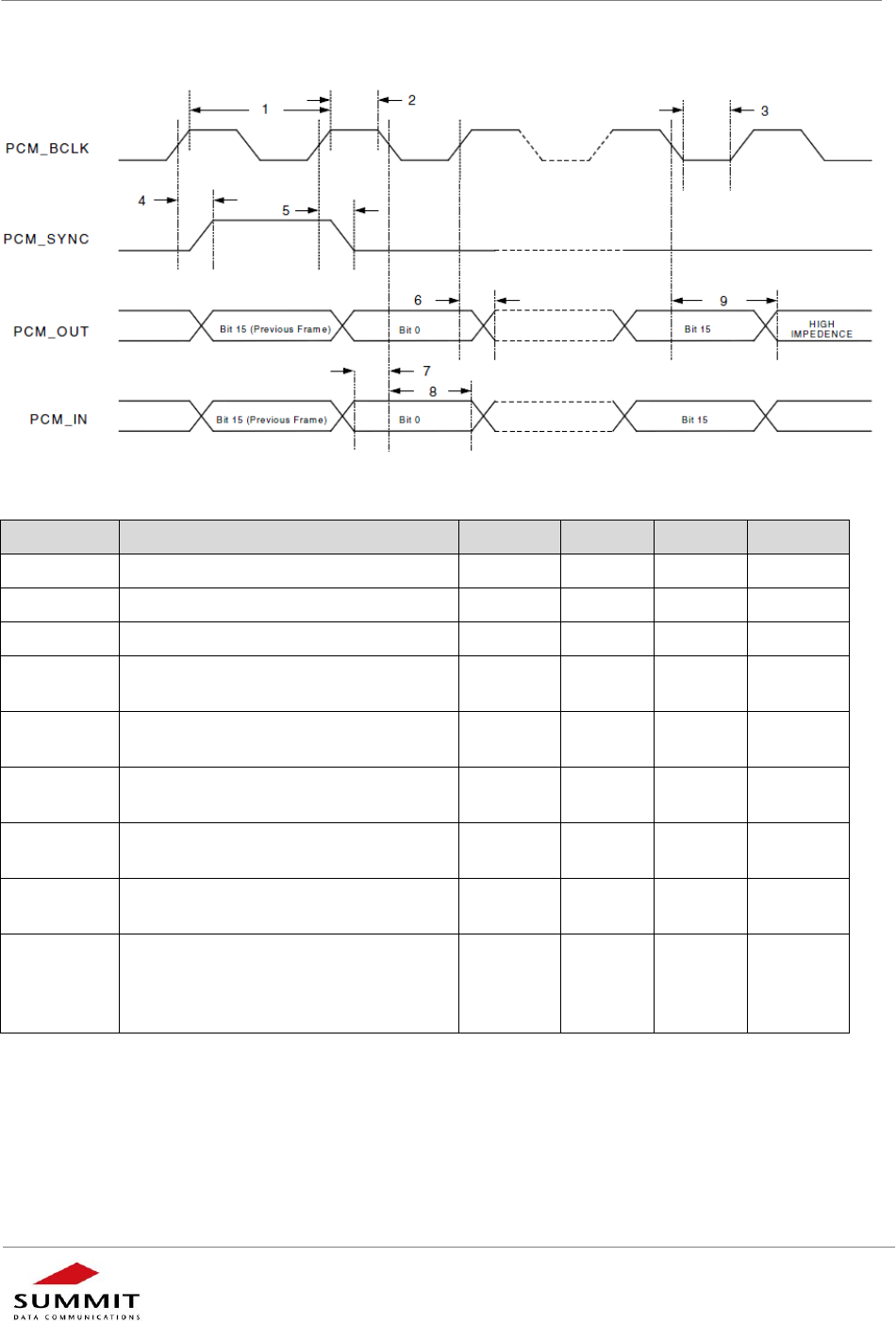
User’s Guide – SDC-MSD40NBT
13
SDC-MSD40NBT_UsersGuide
© 2011 – 2012 Summit Data Communications, Inc. All rights reserved.
Short Frame Sync, Master Mode
Figure 3: Short Frame Sync, Master Mode
Reference
Description
Min.
Typ.
Max.
Unit
1
PCM bit clock frequency
128
-
2048
kHz
2
PCM bit clock high time
128
-
-
ns
3
PCM bit clock low time
209
-
-
ns
4
Delay from BT_PCM_CLK rising edge
to BT_PCM_SYNC high
-
-
50
ns
5
Delay from BT_PCM_CLK rising edge
to BT_PCM_SYNC low
-
-
50
ns
6
Delay from BT_PCM_CLK rising edge
to data valid on BT_PCM_OUT
-
-
50
ns
7
Setup time for BT_PCM_IN before
BT_PCM_CLK falling edge
50
-
-
ns
8
Hold time for BT_PCM_IN after
BT_PCM_CLK falling edge
10
-
-
ns
9
Delay from falling edge of
BT_PCM_CLK during last bit period
to BT_PCM_OUT becoming high
impedance
-
-
50
ns
Table 5: Short Frame Sync, Master Mode
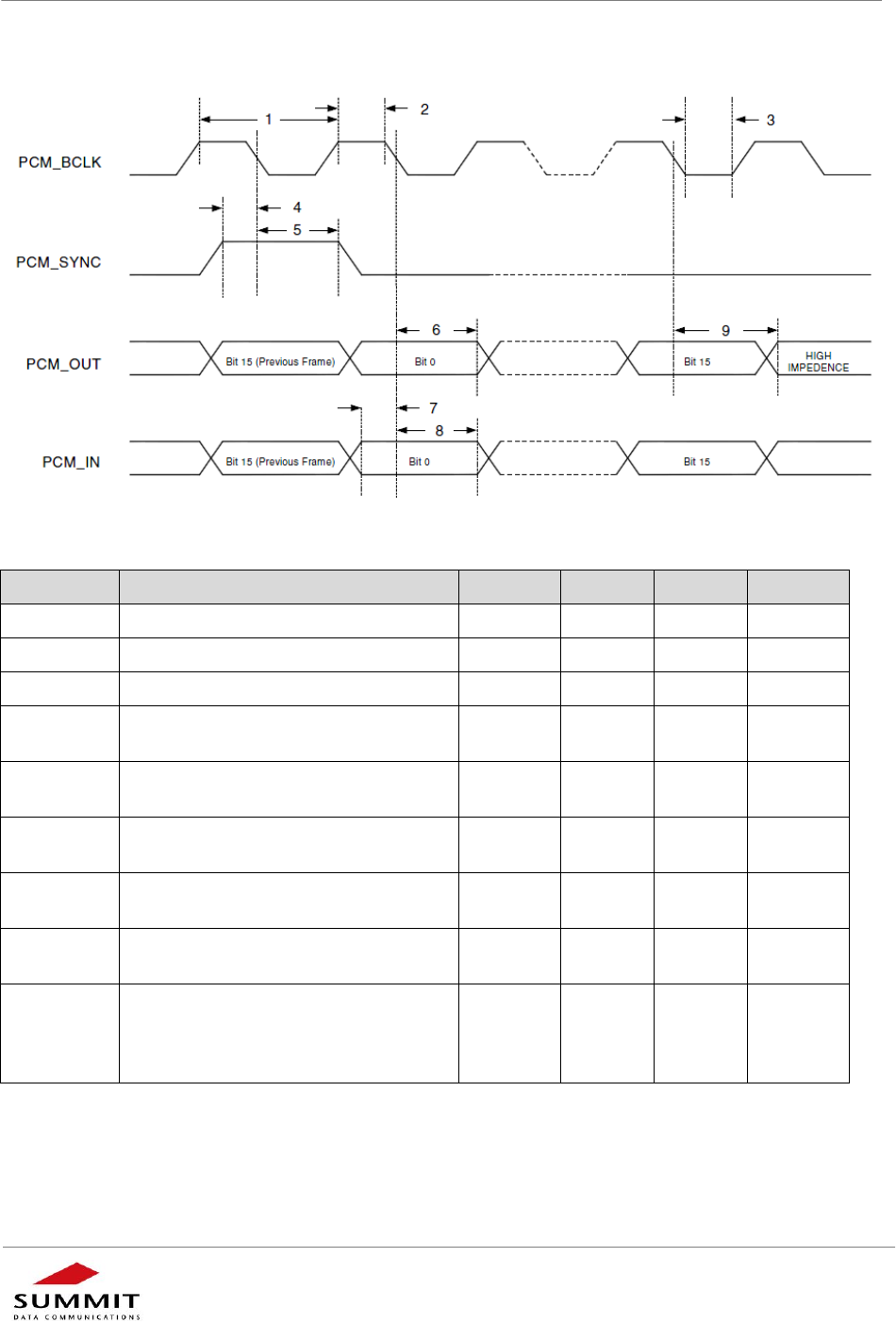
User’s Guide – SDC-MSD40NBT
14
SDC-MSD40NBT_UsersGuide
© 2011 – 2012 Summit Data Communications, Inc. All rights reserved.
Short Frame Sync, Slave Mode
Figure 4: Short Frame Sync, Slave Mode
Reference
Description
Min.
Typ.
Max.
Unit
1
PCM bit clock frequency
128
-
2048
kHz
2
PCM bit clock high time
209
-
-
ns
3
PCM bit clock low time
209
-
-
ns
4
Setup time for BT_PCM_SYNC
before falling edge of BT_PCM_BCLK
50
-
-
ns
5
Hold time for BT_PCM_SYNC after
falling edge of BT_PCM_CLK
10
-
-
ns
6
Hold time of BT_PCM_OUT after
BT_PCM_CLK falling time
-
-
175
ns
7
Setup time for BT_PCM_IN before
BT_PCM_CLK falling edge
50
-
-
ns
8
Hold time for BT_PCM_IN after
BT_PCM_CLK falling edge
10
-
-
ns
9
Delay from falling edge of
BT_PCM_CLK during last bit period
to BT_PCM_OUT becoming high
impedance
-
-
100
ns
Table 6: Short Frame Sync, Slave Mode
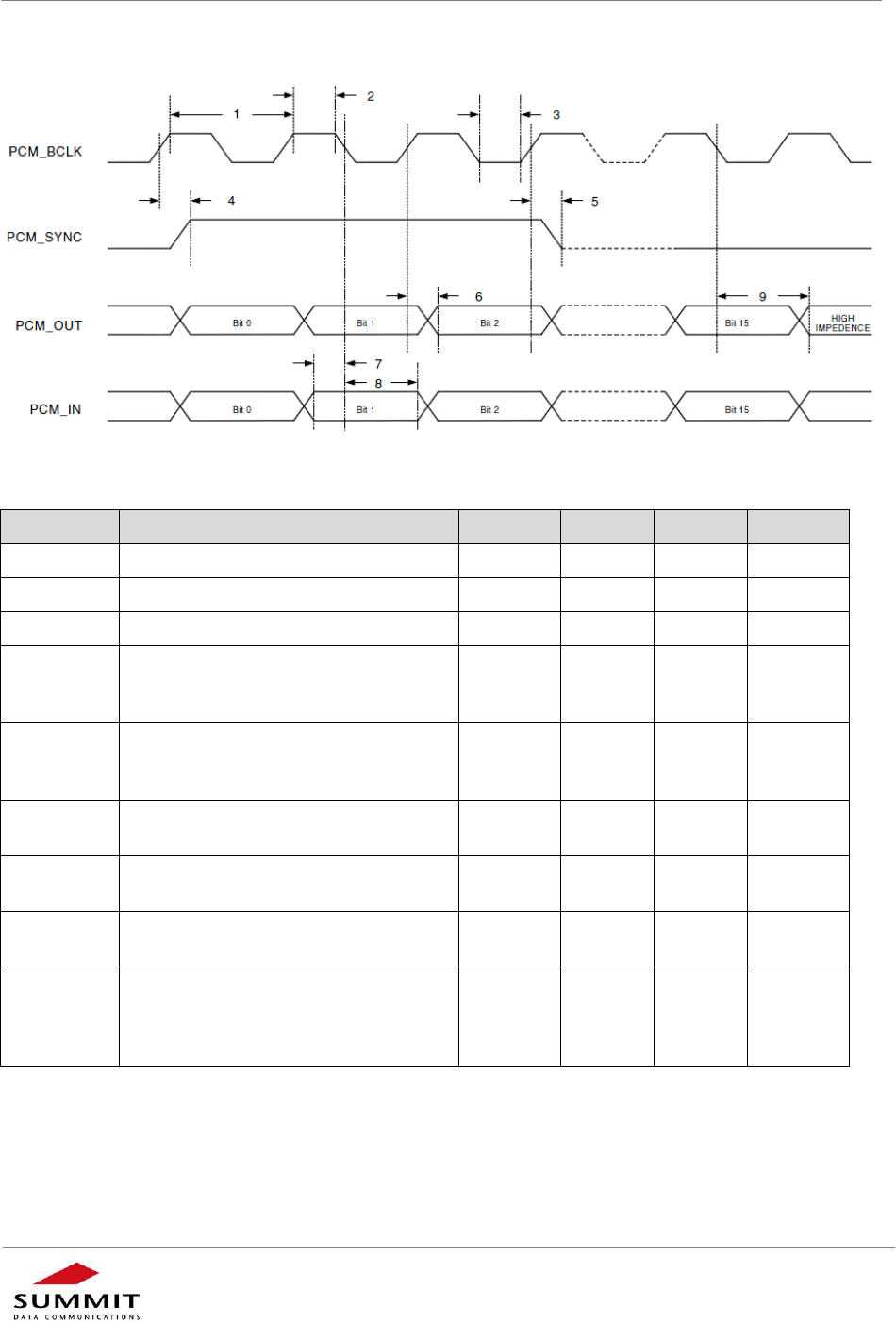
User’s Guide – SDC-MSD40NBT
15
SDC-MSD40NBT_UsersGuide
© 2011 – 2012 Summit Data Communications, Inc. All rights reserved.
Long Frame Sync, Master Mode
Figure 5: Long Frame Sync, Master Mode
Reference
Description
Min.
Typ.
Max.
Unit
1
PCM bit clock frequency
128
-
2048
kHz
2
PCM bit clock high time
209
-
-
ns
3
PCM bit clock low time
209
-
-
ns
4
Delay from BT_PCM_CLK rising edge
to BT_PCM_SYNC high during first
bit time
-
-
50
ns
5
Delay from BT_PCM_CLK rising edge
to BT_PCM_SYNC low during third bit
time
-
-
50
ns
6
Delay from BT_PCM_CLK rising edge
to data valid on BT_PCM_OUT
-
-
50
ns
7
Setup time for BT_PCM_IN before
BT_PCM_CLK falling edge
50
-
-
ns
8
Hold time for BT_PCM_IN after
BT_PCM_CLK falling edge
10
-
-
ns
9
Delay from falling edge of
BT_PCM_CLK during last bit period
to BT_PCM_OUT becoming high
impedance
-
-
50
ns
Table 7: Long Frame Sync, Master Mode
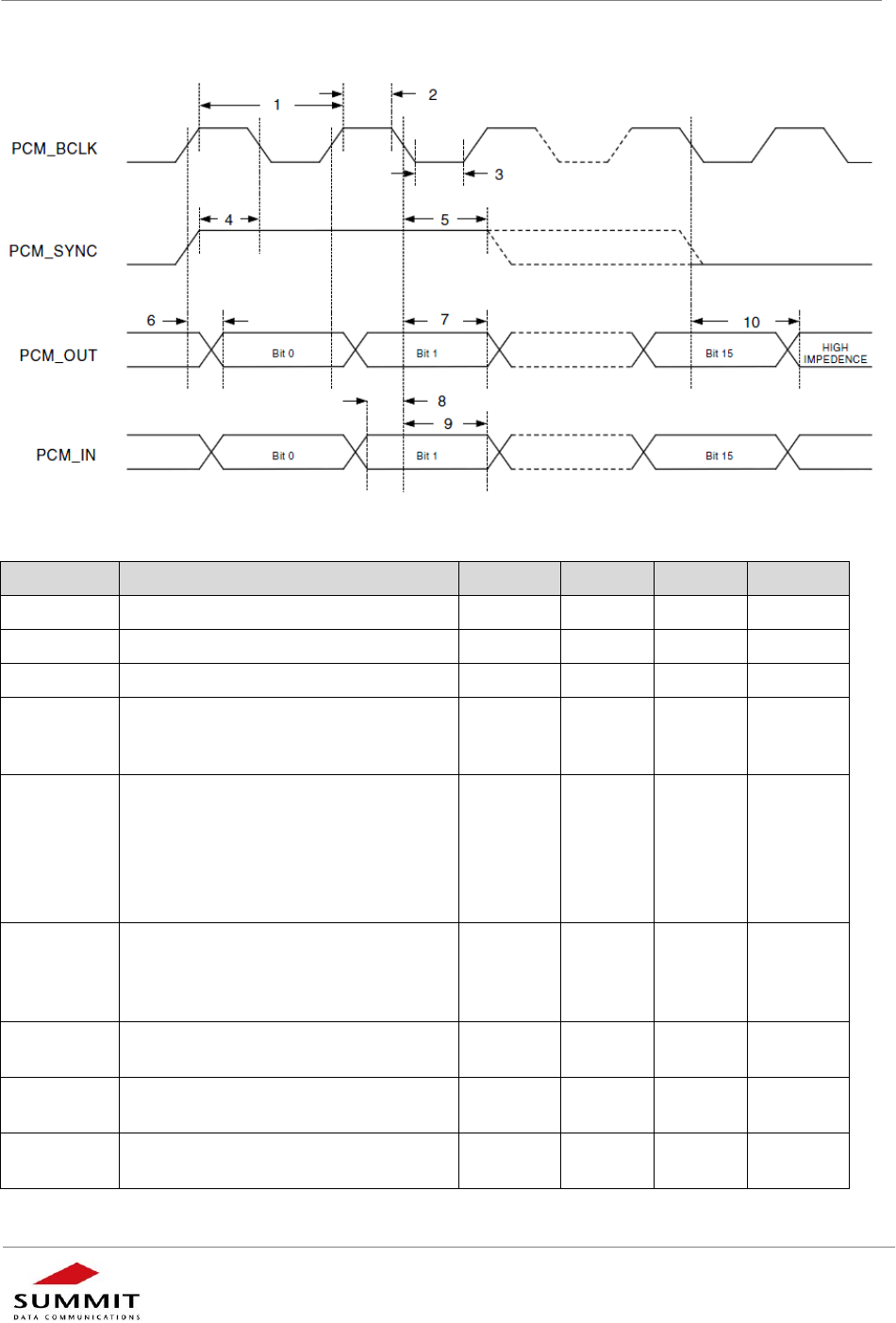
User’s Guide – SDC-MSD40NBT
16
SDC-MSD40NBT_UsersGuide
© 2011 – 2012 Summit Data Communications, Inc. All rights reserved.
Long Frame Sync, Slave Mode
Figure 6: Long Frame Sync, Slave Mode
Reference
Description
Min.
Typ.
Max.
Unit
1
PCM bit clock frequency
128
-
2048
kHz
2
PCM bit clock high time
209
-
-
ns
3
PCM bit clock low time
209
-
-
ns
4
Setup time for BT_PCM_SYNC
before falling edge of BT_PCM_CLK
during first bit time
50
-
-
ns
5
Hold time for BT_PCM_SYNC after
falling edge of BT_PCM_CLK during
second bit period.
Note: BT_PCM_SYNC may go low
any time from second bit period to last
bit period.
10
-
-
ns
6
Delay from rising edge of
BT_PCM_CLK or BT_PCM_SYNC
(whichever is later) to data valid for
first bit on BT_PCM_OUT
-
-
50
ns
7
Hold time of BT_PCM_OUT after
BT_PCM_CLK falling edge
-
-
175
ns
8
Setup time for BT_PCM_IN before
BT_PCM_CLK falling edge
50
-
-
ns
9
Hold time for BT_PCM_IN after
BT_PCM_CLK falling edge
10
-
-
ns
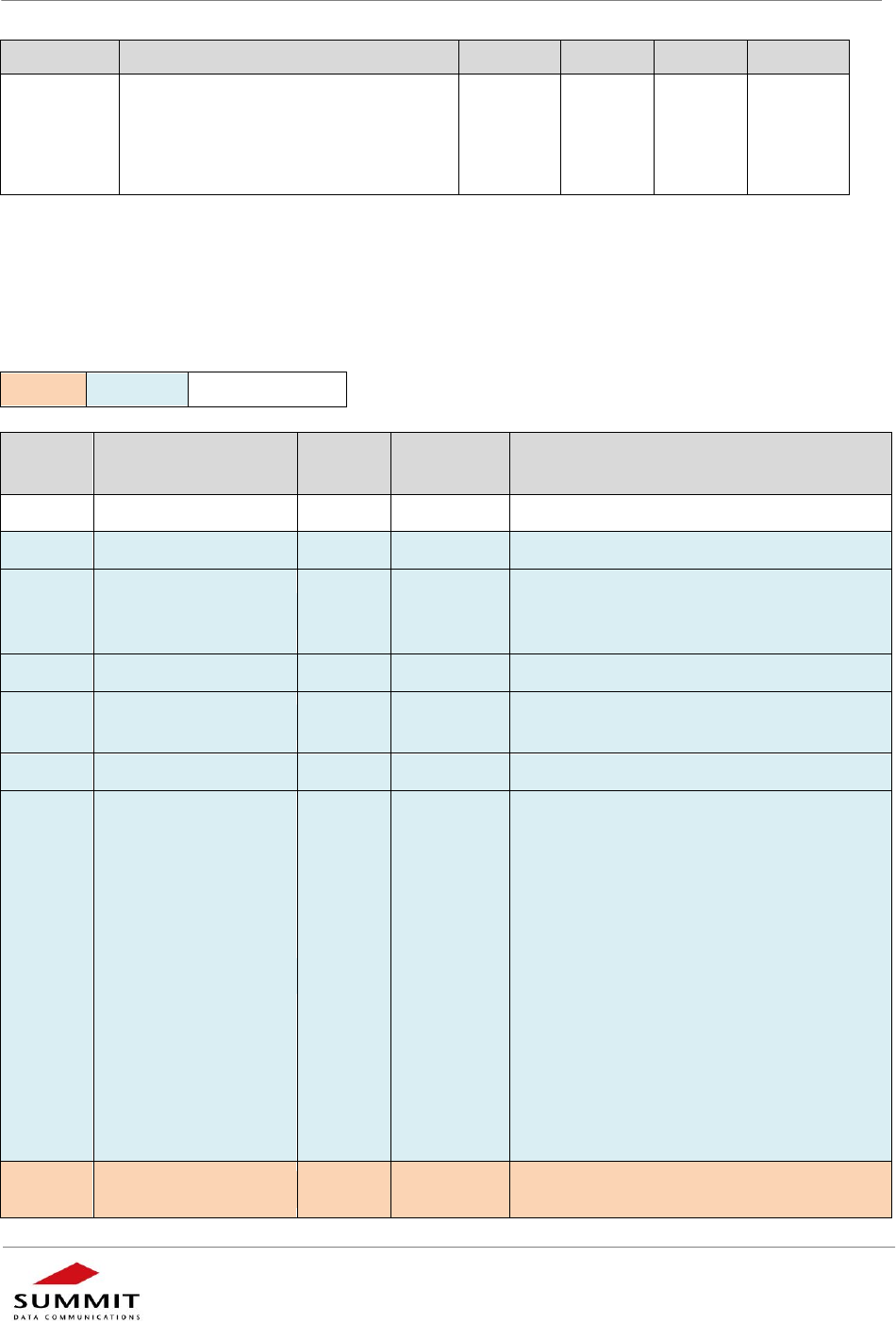
User’s Guide – SDC-MSD40NBT
17
SDC-MSD40NBT_UsersGuide
© 2011 – 2012 Summit Data Communications, Inc. All rights reserved.
Reference
Description
Min.
Typ.
Max.
Unit
10
Delay from falling edge of
BT_PCM_CLK or BT_PCM_SYNC
(whichever is later) during last bit in
slot to BT_PCM_OUT becoming high
impedence
-
-
100
Table 8: Long Frame Sync, Slave Mode
Pin Definitions
Wi-Fi
Bluetooth
Wi-Fi/Bluetooth
Pin
Number
Pin
Name
I/O
Voltage
Reference
Description
1
GND
-
Ground
2
BT_UART_TXD
O
VDDIO
Bluetooth UART Serial Output.
3
BT_PRIORITY
I/O
VDDIO
No connect
Not currently supported in the firmware.
When not in use, leave open (float).
4
BT_GPIO_6
I/O
VDDIO
3.3V I/O Signaling
5
BT_UART_RTS_N
O
VDDIO
Request-to-send signal for the Bluetooth
UART interface, active low.
6
BT_UART_RXD
I
VDDIO
Bluetooth UART Serial Input.
7
BT_HOST_WAKE_B
O
Host Wake-up
Signal from the MSD40NBT to the host
indicating that the radio requires attention.
Asserted – Host device must wake-up or
remain awake.
Deasserted – Host device may sleep when
sleep criteria are met
The signal polarity is software configurable
and can be asserted high or low.
Note: The default is low but this is only
applicable for specific Bluetooth Sleep
mode settings. By default, the radio has
“No Sleep Mode Set”.
8
RSVD
O
VDDIO
Reserved for Wake on Wireless
Wake on Wireless is not currently
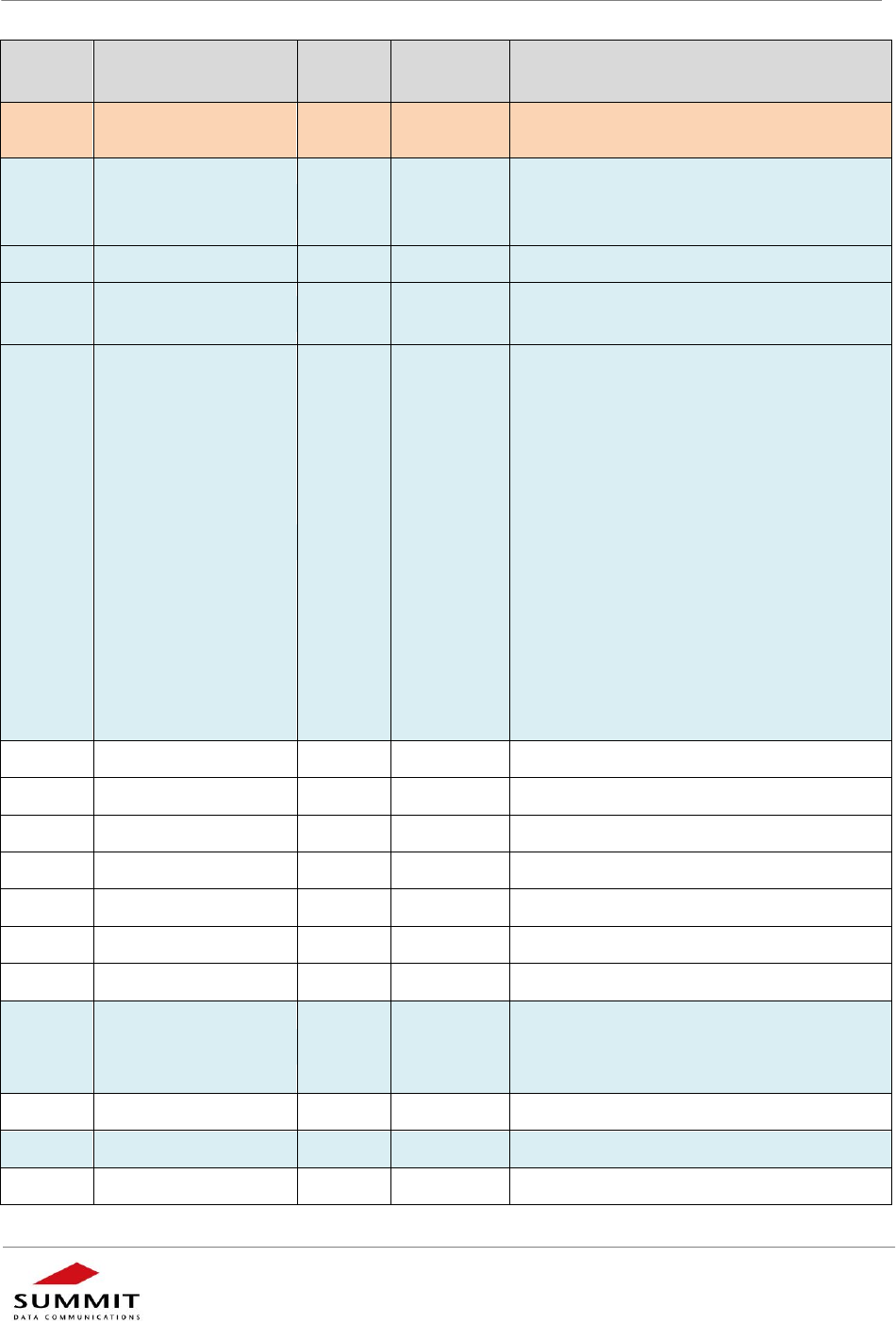
User’s Guide – SDC-MSD40NBT
18
SDC-MSD40NBT_UsersGuide
© 2011 – 2012 Summit Data Communications, Inc. All rights reserved.
Pin
Number
Pin
Name
I/O
Voltage
Reference
Description
supported in the radio firmware.
Do not connect when not used
9
RSVD
O
VDDIO
Reserved.
Bluetooth LED Activity Indicator,
active high.
10
BT_PCM_OUT
O
VDDIO
PCM data output
11
BT_UART_CTS_N
I
VDDIO
Clear-to-send signal for the Bluetooth
UART interface, active low.
12
RSVD
I
VDDIO
Bluetooth Device Wake-up
Signal from the host to the SDC-
MSD40NBT indicating that the host
requires attention.
Asserted – Bluetooth device must wake-up
or remain awake
Deasserted – Bluetooth device may sleep
when sleep criteria are met
The signal polarity is software configurable
and can be asserted high or low.
Note: The default is low but this is only
applicable for specific Bluetooth Sleep
mode settings. By default, the radio has
“No Sleep Mode Set”.
13
VCC3_3
-
3.3V Module Power
14
No Connect
Not Used. Leave Open (Float)
15
No Connect
Not Used. Leave Open (Float)
16
No Connect
Not Used. Leave Open (Float)
17
No Connect
Not Used. Leave Open (Float)
18
No Connect
Not Used. Leave Open (Float)
19
No Connect
Not Used. Leave Open (Float)
20
BT_PCM_SYNC
I/O
VDDIO
PCM sync signal
Default master (output); can be configured
slave (input)
21
No Connect
Not Used. Leave Open (Float)
22
BT_PCM_IN
I
VDDIO
PCM data input
23
No Connect
Not Used. Leave Open (Float)
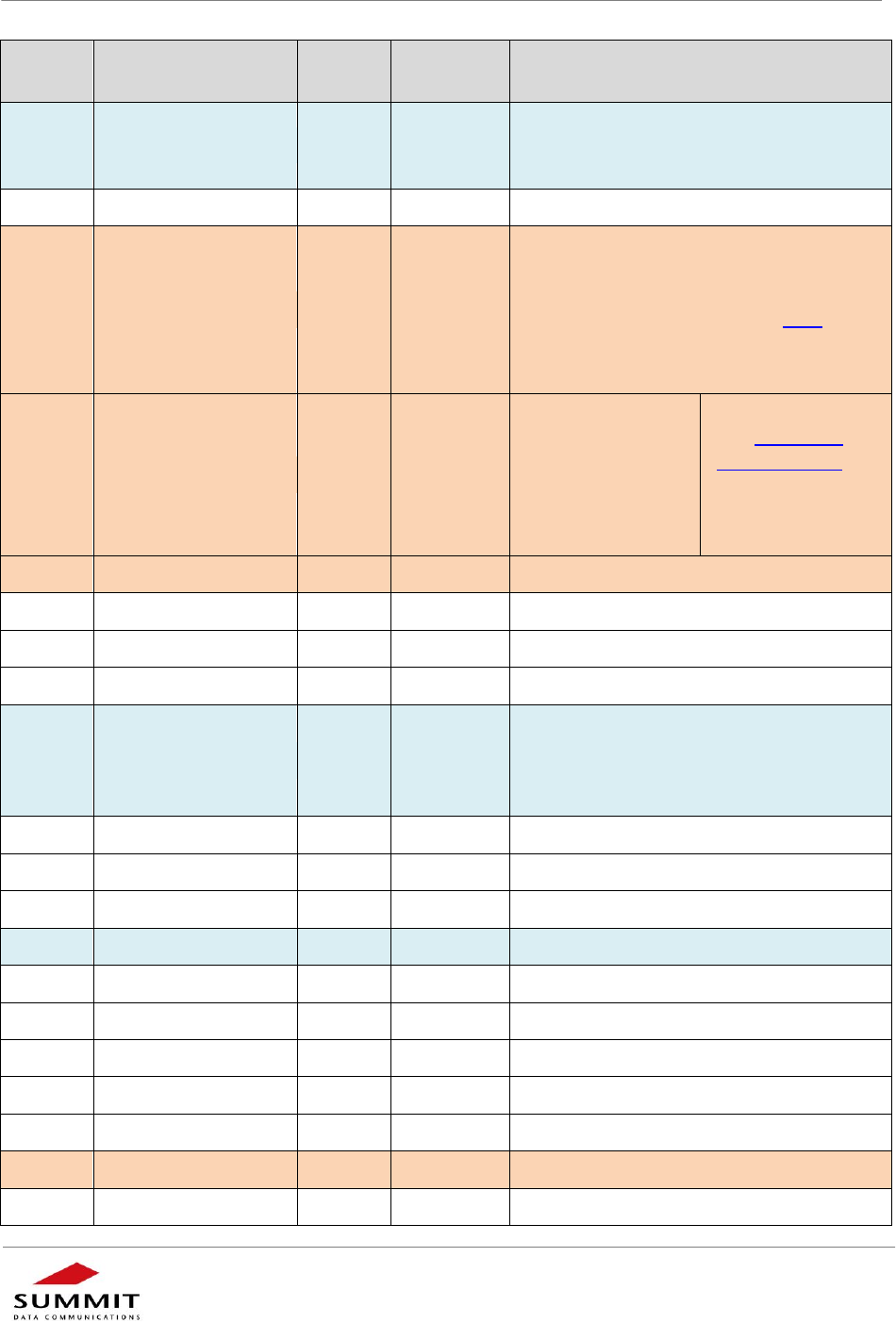
User’s Guide – SDC-MSD40NBT
19
SDC-MSD40NBT_UsersGuide
© 2011 – 2012 Summit Data Communications, Inc. All rights reserved.
Pin
Number
Pin
Name
I/O
Voltage
Reference
Description
24
BT_PCM_CLK
I/O
VDDIO
PCM clock
Default master (output):
can be configured slave (input)
25
No Connect
Not Used. Leave Open (Float)
26
SYS_RST_L
I
VDDIO
Resets the Wi-Fi radio, active low. Must
be asserted when power is first applied to
the radio; then released before any
transaction can start (see Note).
See “Electrical Considerations” for the
recommended SYS_RST_L circuitry)
27
SDIO_DATA_2
I/O
VDDIO
SDIO Data 2
Note: See
“Integration
Considerations” for
additional
integration
information.
28
RSVD
O
VDDIO
Reserved. No Connect.
29
VCC3_3
-
3.3V Module Power
30
GND
-
Ground
31
GND
-
Ground
32
BT_RST_L
I
VDDIO
Resets the BT radio, active low. Must be
asserted when power is first applied to the
radio; then released before any transaction
can start.
33
No Connect
Not Used. Leave Open (Float)
34
No Connect
Not Used. Leave Open (Float)
35
No Connect
Not Used. Leave Open (Float)
36
RSVD
I/O
VDDIO
Reserved. No Connect.
37
No Connect
Not Used. Leave Open (Float)
38
No Connect
Not Used. Leave Open (Float)
39
No Connect
Not Used. Leave Open (Float)
40
No Connect
Not Used. Leave Open (Float)
41
No Connect
Not Used. Leave Open (Float)
42
RSVD
O
VDDIO
Reserved. No Connect.
43
No Connect
Not Used. Leave Open (Float)
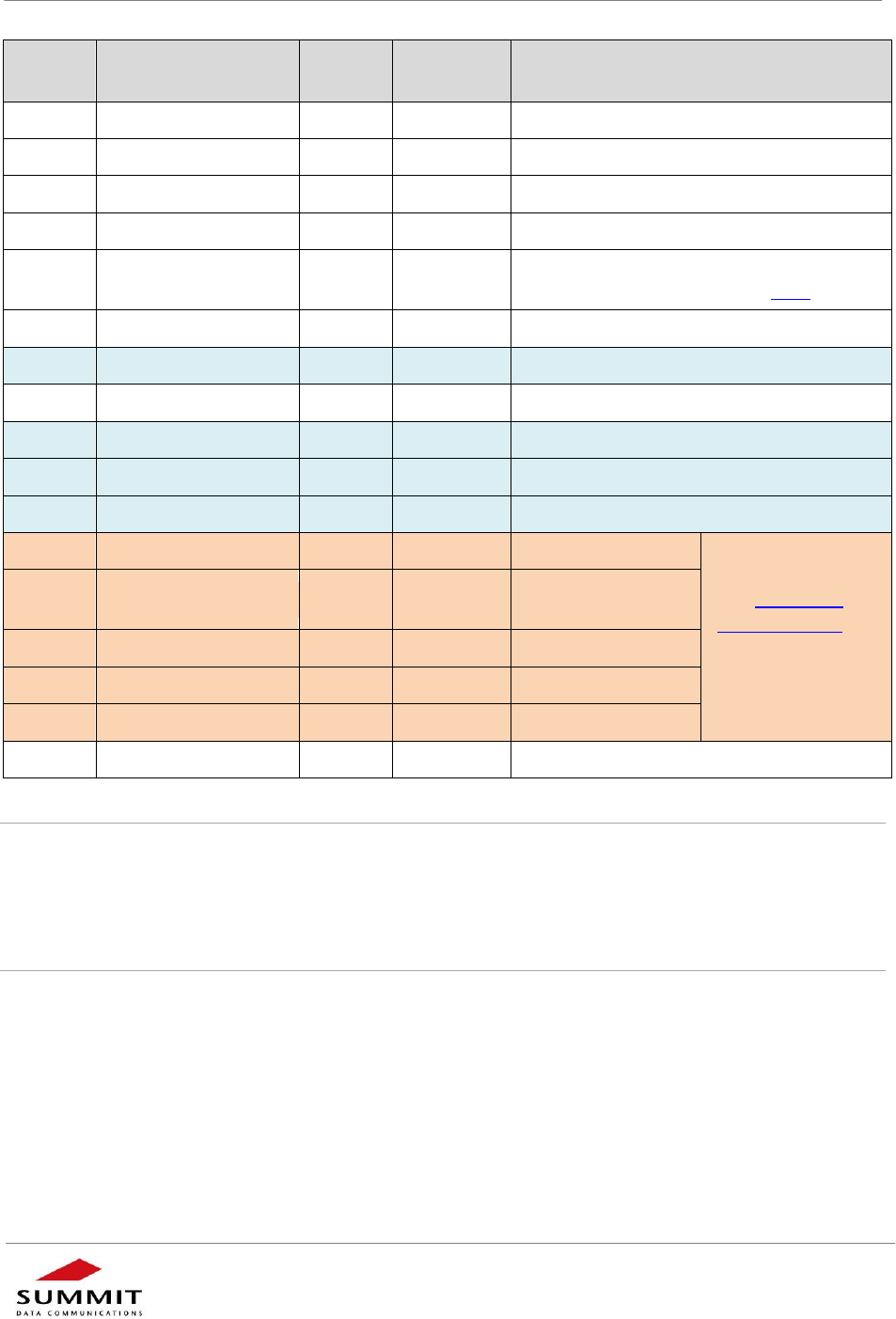
User’s Guide – SDC-MSD40NBT
20
SDC-MSD40NBT_UsersGuide
© 2011 – 2012 Summit Data Communications, Inc. All rights reserved.
Pin
Number
Pin
Name
I/O
Voltage
Reference
Description
44
No Connect
Not Used. Leave Open (Float)
45
No Connect
Not Used. Leave Open (Float)
46
No Connect
Not Used. Leave Open (Float)
47
No Connect
Not Used. Leave Open (Float)
48
CHIP_PWD_L
I
VDDIO
Powers down both the BT and WLAN
radios, active low (see Note).
49
No Connect
Not Used. Leave Open (Float)
50
RSVD
I/O
VDDIO
Reserved for GPIO
51
No Connect
Not Used. Leave Open (Float)
52
RSVD
I/O
VDDIO
Reserved for GPIO
53
RSVD
I/O
VDDIO
Reserved for GPIO
54
RSVD
I/O
VDDIO
Reserved for GPIO
55
SDIO_CMD
I/O
VDDIO
SDIO Command
Note: See
“Integration
Considerations” for
additional
integration
information.
56
SDIO_CLK
I
VDDIO
SDIO Clock (25MHz
max)
57
SDIO_DATA_0
I/O
VDDIO
SDIO Data 0
58
SDIO_DATA_3
I/O
VDDIO
SDIO Data 3
59
SDIO_DATA_1
I/O
VDDIO
SDIO Data 1
60
GND
-
Ground
Table 9: Pin Definitions
Note Regarding SYS_RST_L and CHIP_PWD_L:
Simply releasing SYS_RST_L and CHIP_PWD_L does not guarantee that the BCM4329 chip in
the SSD40NBT module comes out of reset. Ensure that both VDD and VDDIO have been applied
to the SSD40NBT for at least 110 ms before attempting to initiate SDIO communications. A
slightly longer delay is better (safer).
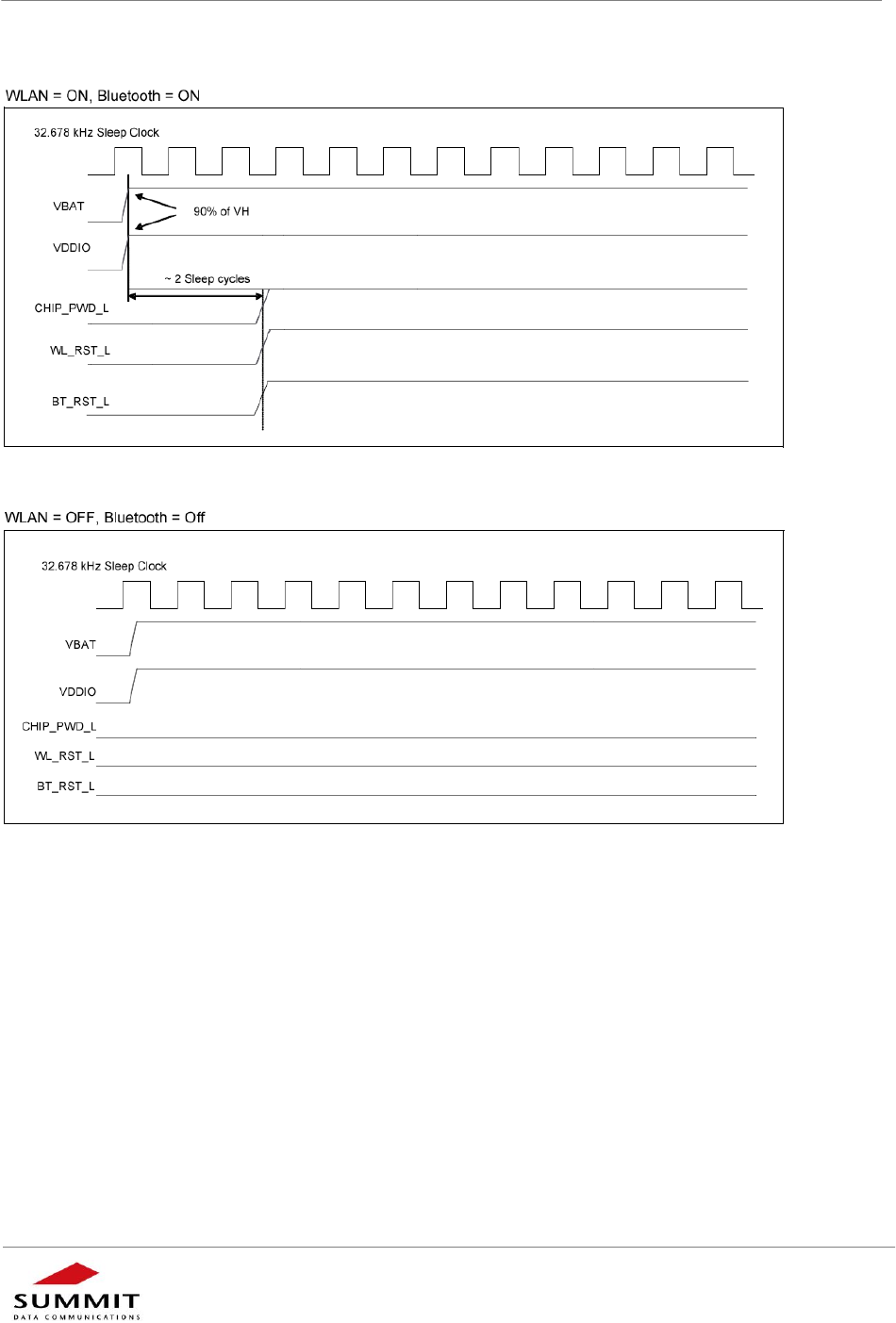
User’s Guide – SDC-MSD40NBT
21
SDC-MSD40NBT_UsersGuide
© 2011 – 2012 Summit Data Communications, Inc. All rights reserved.
Control Signal Timing Diagrams
Figure 7: WLAN = ON, Bluetooth = ON
Figure 8: WLAN = OFF, Bluetooth = OFF
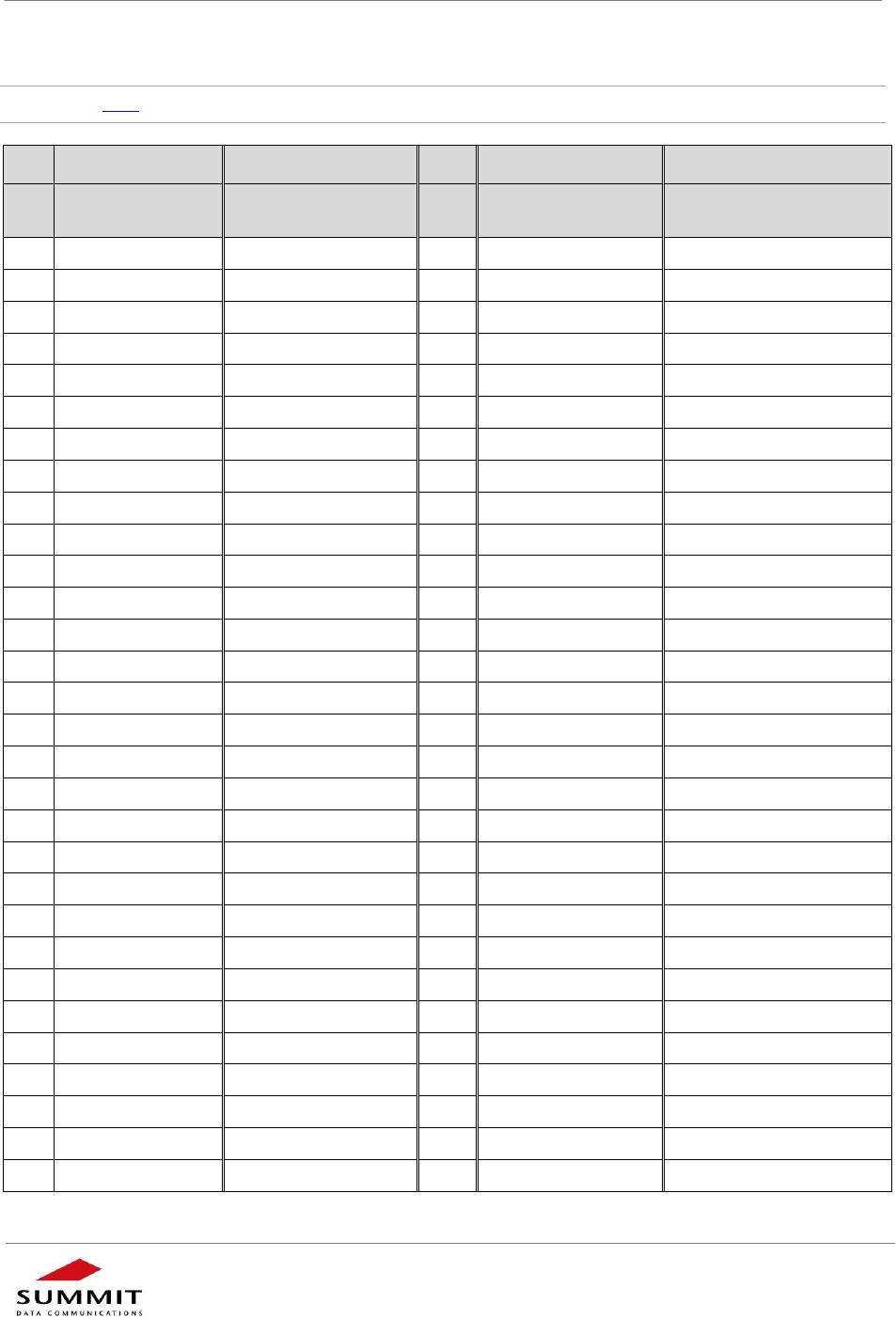
User’s Guide – SDC-MSD40NBT
22
SDC-MSD40NBT_UsersGuide
© 2011 – 2012 Summit Data Communications, Inc. All rights reserved.
MSD30AG and MSD40NBT Pin Comparison Table
Note: Click here for a pin comparison table for the MSD10AG, MSD30AG, and MSD40NBT devices.
MSD30AG
MSD40NBT
SSD30AG
SSD40NBT
Pin
#
Pin Name
Pin Name
Pin
#
Pin Name
Pin Name
1
GND
GND
31
GND
GND
2
RSVD
BT_UART_TXD
32
RSVD
BT_RST_L
3
BT_PRIORITY
BT_PRIORITY
33
No Connect
No Connect
4
BT_FREQ
BT_GPIO_6
34
No Connect
No Connect
5
RSVD
BT_UART_RTS_N
35
No Connect
No Connect
6
RSVD
BT_UART_RXD
36
BT_ACTIVE
BT_ACTIVE
7
RSVD
BT_HOST_WAKE_B
37
No Connect
No Connect
8
WL_GPIO_1
RSVD
38
No Connect
No Connect
9
RSVD
RSVD
39
No Connect
No Connect
10
RSVD
BT_PCM_OUT
40
No Connect
No Connect
11
RSVD
BT_UART_CTS_N
41
No Connect
No Connect
12
RSVD
RSVD
42
WL_LED_ACT
WL_LED_ACT
13
VCC3_3
VCC3_3
43
No Connect
No Connect
14
No Connect
No Connect
44
No Connect
No Connect
15
No Connect
No Connect
45
No Connect
No Connect
16
No Connect
No Connect
46
No Connect
No Connect
17
No Connect
No Connect
47
No Connect
No Connect
18
No Connect
No Connect
48
CHIP_PWD_L
CHIP_PWD_L
19
No Connect
No Connect
49
No Connect
No Connect
20
RSVD
BT_PCM_SYNC
50
RSVD
RSVD
21
No Connect
No Connect
51
No Connect
No Connect
22
RSVD
BT_PCM_IN
52
RSVD
RSVD
23
No Connect
No Connect
53
RSVD
BT_GPIO_7
24
RSVD
BT_PCM_CLK
54
RSVD
RSVD
25
No Connect
No Connect
55
SDIO_CMD
SDIO_CMD
26
SYS_RST_L
SYS_RST_L
56
SDIO_CLK
SDIO_CLK
27
SDIO_DATA_2
SDIO_DATA_2
57
SDIO_DATA_0
SDIO_DATA_0
28
WLAN_ACTIVE
RSVD
58
SDIO_DATA_3
SDIO_DATA_3
29
VCC3_3
VCC3_3
59
SDIO_DATA_1
SDIO_DATA_1
30
GND
GND
60
GND
GND
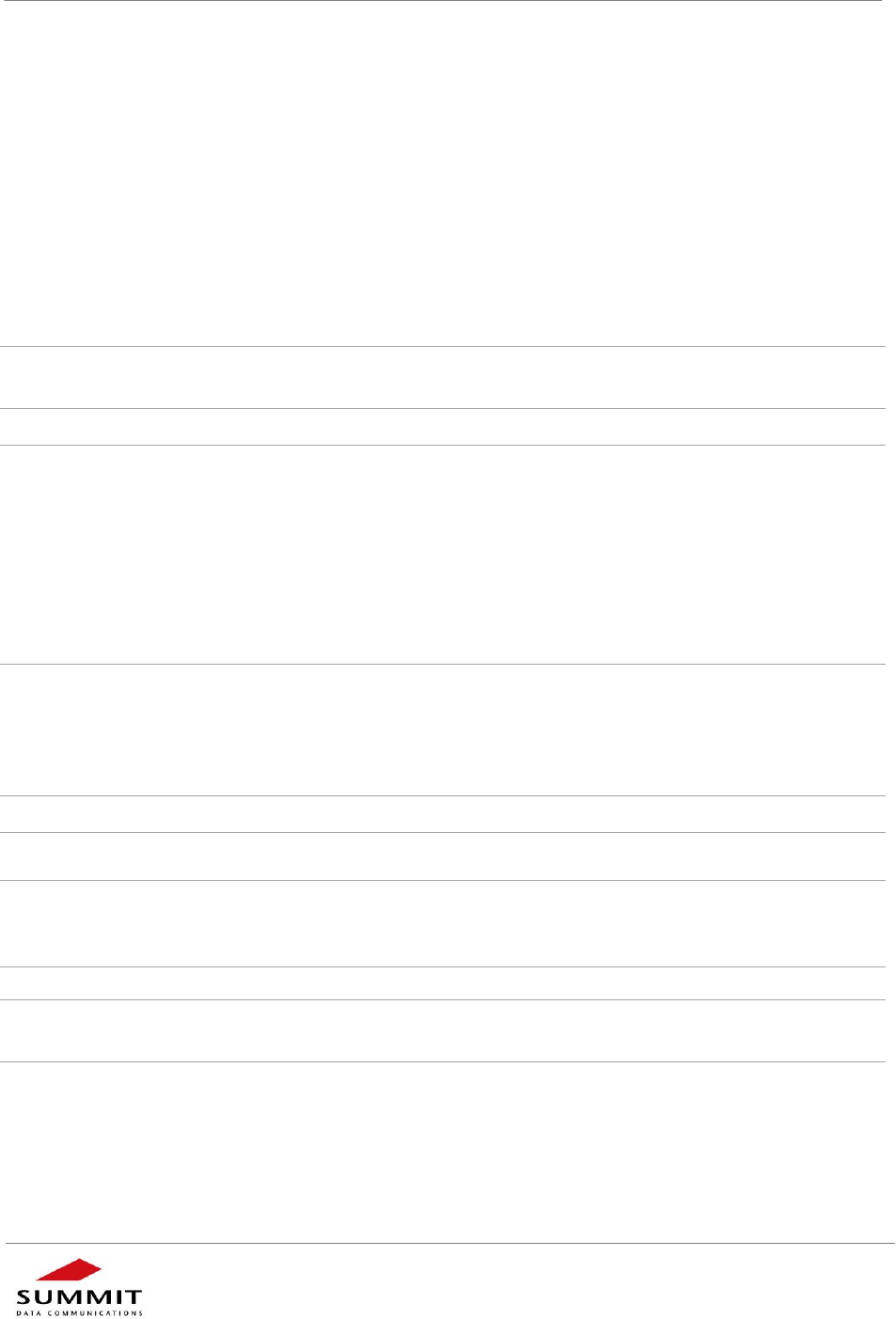
User’s Guide – SDC-MSD40NBT
23
SDC-MSD40NBT_UsersGuide
© 2011 – 2012 Summit Data Communications, Inc. All rights reserved.
Integration Considerations
The following Wi-Fi information should be taken into consideration when integrating the SSD40NBT.
Series resistors are recommended in all six SDIO lines (27-56 ohms typically):
SDIO_CLK
SDIO_CMD
SDIO_DATA_0
SDIO_DATA_1
SDIO_DATA_2
SDIO_DATA_3
Note: Although these values may vary with the properties of your host interface and the PCB, they are a
reasonable starting point.
Note: The series resistors in the SDIO bus provide several design benefits:
- If a host controller has too high of a drive strength, then bus ringing may result. Series resistors
can reduce this ringing on the I/O lines.
- Adding 27-56 ohms of series resistance on the SDIO bus will reduce sharp transitional edges,
which may reduce EMI.
- Having the series resistors in the PCB layout allows for design flexibility; If they are later found to
be unnecessary, zero (0) ohm jumpers may be used in their place
The following are also recommended:
47 K ohm pull-ups on the CMD line and four data lines: SDIO_CMD, SDIO_DATA_0, SDIO_DATA_1,
SDIO_DATA_2, SDIO_DATA_3
Note: No pull-up is required on the CLK line.
Note: Make sure to apply the proper voltage on the VDDIO input to the SiP to match the signaling
voltage of the SDIO host interface (1.8V or 3.3V typically, but it can be anything in between these
values).
Note: The SDIO host must wait a minimum of 110 ms before initiating access to the SDC-MSD40NBT
after VDD ramps up and settles.
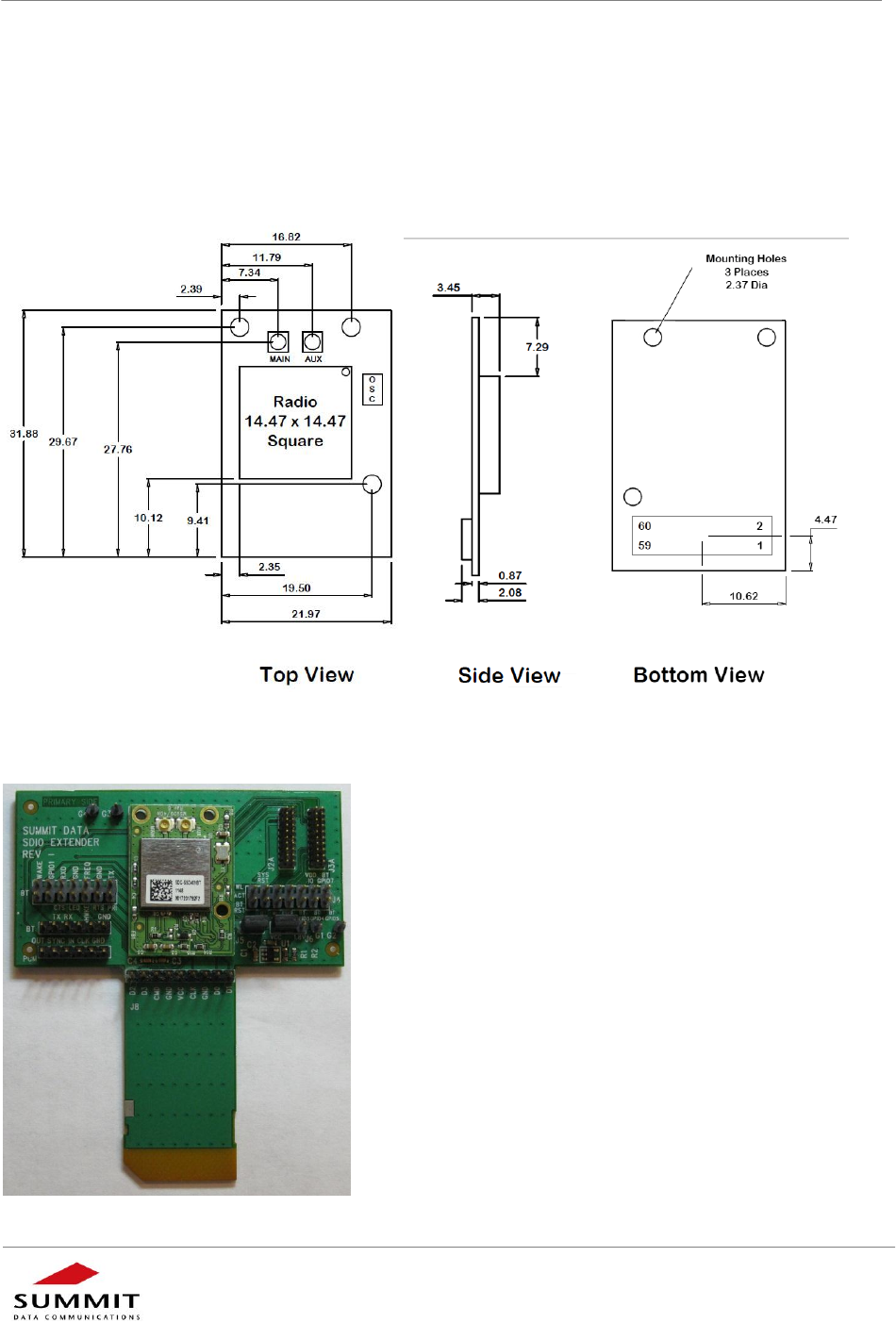
User’s Guide – SDC-MSD40NBT
24
SDC-MSD40NBT_UsersGuide
© 2011 – 2012 Summit Data Communications, Inc. All rights reserved.
Mechanical Specifications
Connector Overview
MSD40NBT connector: Molex 54722-0607 60-pin connector
Mating connector (on board): Molex 55560-0607 60-pin connector
Figure 9: Mechanical Drawing
MSD40NBT Attached to T-Board
Figure 10: MSD40NBT attached to T-board
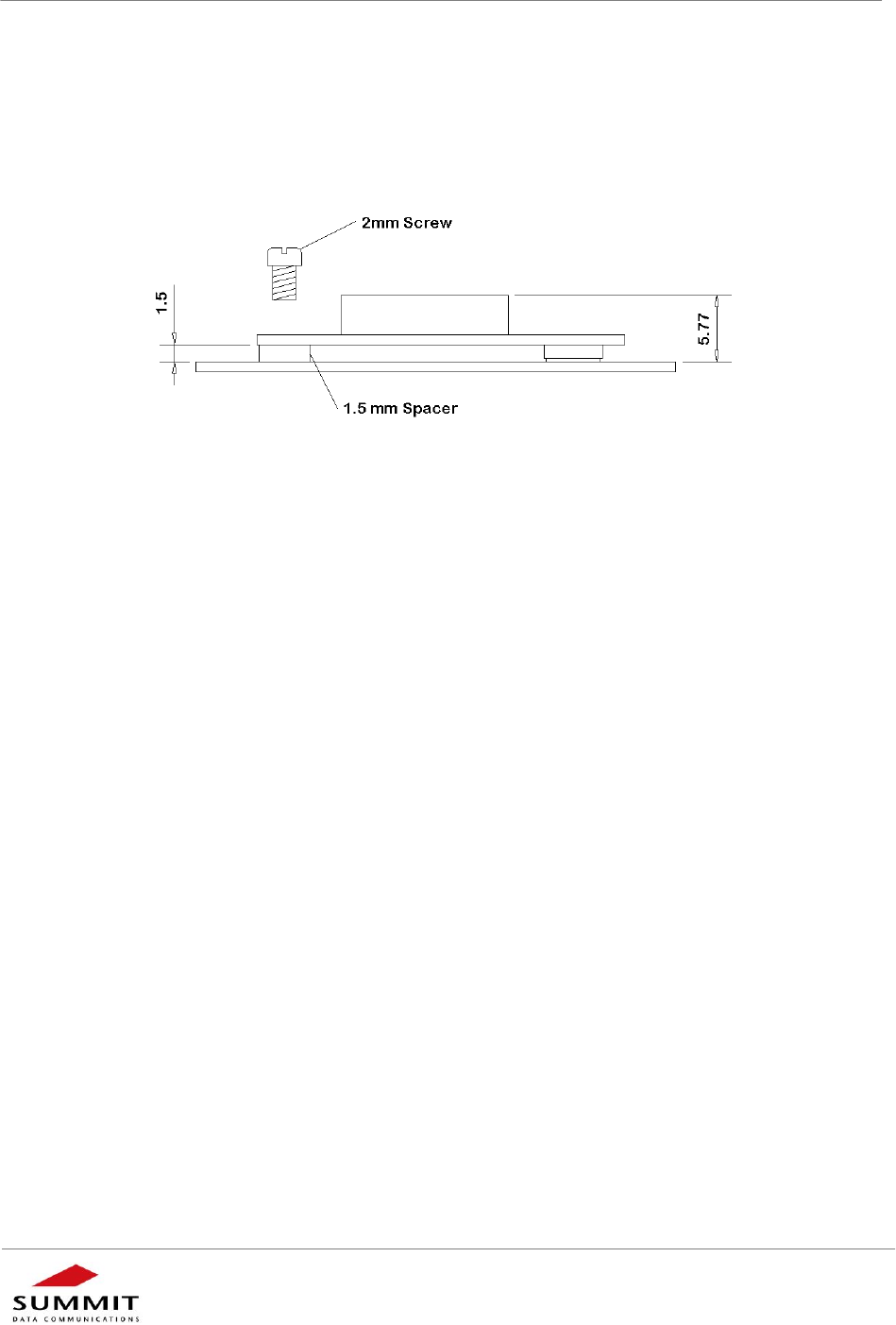
User’s Guide – SDC-MSD40NBT
25
SDC-MSD40NBT_UsersGuide
© 2011 – 2012 Summit Data Communications, Inc. All rights reserved.
Mounting
Three through-hole mounting with a 60-pin connector. Summit recommends a 1.5 mm bushing with a
conductive mounting screw to connect the exposed ground pads of the radio circuit board to the host
ground plane. A 1.5 mm conductive bushing with a maximum OD of 3.5 mm will maximize grounding of
the radio and help to reduce emissions from the radio circuit board.
Figure 11: Mounting Recommendations
RF Layout Design Guidelines
The following is a list of RF layout design guidelines and recommendation when installing a Summit radio
into your device.
Do not run antenna cables directly above or directly below the radio.
Do not place any parts or run any high speed digital lines below the radio.
If there are other radios or transmitters located on the device (such as a Bluetooth radio), place the
devices as far apart from each other as possible.
Ensure that there is the maximum allowable spacing separating the antenna connectors on the
Summit radio from the antenna. In addition, do not place antennas directly above or directly below the
radio.
Summit recommends the use of a double shielded cable for the connection between the radio and the
antenna elements.
Summit has provided three plated mounting holes that can be used for grounding. When additional
ground plane is required, you may use some or all of these grounded mounting holes.
Use proper electro-static-discharge (ESD) procedures when installing the Summit radio module.

User’s Guide – SDC-MSD40NBT
26
SDC-MSD40NBT_UsersGuide
© 2011 – 2012 Summit Data Communications, Inc. All rights reserved.
Regulatory
Certified Antennas
The SDC-MSD40NBT will be tested to the regulatory standards defined in the “Certifications” section of
the Specifications table above. Summit plans to conduct these tests with the following antennas:
Cisco AIR-ANT 4941
Form Factor: Whip
Type: Dipole
Maximum 2.4 GHz Gain: 2.2 dBi
Tested and Certified 2.4 GHz Transmit Power: TBD
Radiall Larson Dipole (R380500314)
Form Factor: Whip
Type: Dipole
Maximum 2.4 GHz Gain: 1.6 dBi (not used during testing)
Maximum 5 GHz Gain: 5 dBi
Tested and Certified 5 GHz Transmit Power: TBD
Note: If the formal test reports for the SDC-MSD40NBTshow that transmit power was decreased to less
than 100% on 2.4 GHz edge channels. Summit will make these transmit power reductions in
firmware for the edge channels. Integrators do not need to reduce transmit power on a channel-
by-channel basis to comply with band edge regulations.
Antennas of differing types and higher gains may be integrated as well. If necessary, with the Summit
Manufacturing Utility software utility, OEMs may reduce the transmit power of the SDC-MSD40NBT to
account for higher antenna gain. In some cases, OEMs may be able to reduce certification efforts by
using antennas that are of like type and equal or lesser gain to the above listed antennas.
Documentation Requirements
In order to maintain regulatory compliance, when integrating the SDC-MSD40NBT into a host device and
leveraging Summit’s grants and certifications, it is necessary to meet the documentation requirements set
forth by the applicable regulatory agencies. The following sections (FCC, Industry Canada, and European
Union) outline the information that may be included in the user’s guide and external labels for the host
devices into which the SDC-MSD40NBT is integrated.
FCC
Note: You must place “Contains FCC ID: TWG-SDCMSD40NBT” on the host product in such a location
that it can be seen by an operator at the time of purchase.
User’s Guide Requirements
When integrating the SDC-MSD40NBT into a host device, the integrator must include specific information
in the user’s guide for the device into which the SDC-MSD40NBT is integrated. The integrator must not

User’s Guide – SDC-MSD40NBT
27
SDC-MSD40NBT_UsersGuide
© 2011 – 2012 Summit Data Communications, Inc. All rights reserved.
provide information to the end user regarding how to install or remove this RF module in the user’s
manual of the device into which the SDC-MSD40NBT is integrated. The following FCC statements must
be added in their entirety and without modification into a prominent place in the user’s guide for the
device into which the SDC-MSD40NBT is integrated:
Federal Communication Commission Interference Statement
This equipment has been tested and found to comply with the limits for a Class B digital device,
pursuant to Part 15 of the FCC Rules. These limits are designed to provide reasonable protection
against harmful interference in a residential installation. This equipment generates, uses, and can
radiate radio frequency energy and, if not installed and used in accordance with the instructions, may
cause harmful interference to radio communications. However, there is no guarantee that interference
will not occur in a particular installation. If this equipment does cause harmful interference to radio or
television reception, which can be determined by turning the equipment off and on, the user is
encouraged to try to correct the interference by one of the following measures:
1. Reorient or relocate the receiving antenna.
2. Increase the separation between the equipment and receiver.
3. Connect the equipment into an outlet on a circuit different from that to which the receiver is
connected.
4. Consult the dealer or an experienced radio/TV technician for help.
FCC Caution: Any changes or modifications not expressly approved by the party responsible for
compliance could void the user's authority to operate this equipment.
This device complies with Part 15 of the FCC Rules. Operation is subject to the following two
conditions: (1) This device may not cause harmful interference, and (2) this device must accept any
interference received, including interference that may cause undesired operation.
IMPORTANT NOTE: FCC Radiation Exposure Statement:
This equipment complies with FCC radiation exposure limits set forth for an uncontrolled
environment. This equipment should be installed and operated with minimum distance 20cm between
the radiator & your body.
Labeling Requirements
The final end product must be labeled in a visible area with the following notice:
Contains FCC ID: TWG-SDCMSD40NBT
Industry Canada
Note: You must place “Contains IC ID: 6616A-SDCMSD40NBT” on the host product in such a location
that it can be seen by an operator at the time of purchase.

User’s Guide – SDC-MSD40NBT
28
SDC-MSD40NBT_UsersGuide
© 2011 – 2012 Summit Data Communications, Inc. All rights reserved.
User’s Guide Requirements (for Model # SDC-MSD40NBT)
RF Radiation Hazard Warning
To ensure compliance with FCC and Industry Canada RF exposure requirements, this device must be
installed in a location where the antennas of the device will have a minimum distance of at least 20 cm
from all persons. Using higher gain antennas and types of antennas not certified for use with this product
is not allowed. The device shall not be co-located with another transmitter.
Installez l'appareil en veillant à conserver une distance d'au moins 20 cm entre les éléments rayonnants
et les personnes. Cet avertissement de sécurité est conforme aux limites d'exposition définies par la
norme CNR-102 at relative aux fréquences radio.
Maximum Antenna Gain – If the integrator configures the device such that the antenna is
detectable from the host product.
This radio transmitter (IC ID: 6616A-SDCMSD40NBT) has been approved by Industry Canada to operate
with the antenna types listed below with the maximum permissible gain and required antenna impedance
for each antenna type indicated. Antenna types not included in this list, having a gain greater than the
maximum gain indicated for that type, are strictly prohibited for use with this device.
Le présent émetteur radio (IC ID: 6616A-SDCMSD40NBT) a été approuvé par Industrie Canada pour
fonctionner avec les types d'antenne énumérés ci-dessous et ayant un gain admissible maximal et
l'impédance requise pour chaque type d'antenne. Les types d'antenne non inclus dans cette liste, ou dont
le gain est supérieur au gain maximal indiqué, sont strictement interdits pour l'exploitation de l'émetteur.
Under Industry Canada regulations, this radio transmitter may only operate using an antenna of a type
and maximum (or lesser) gain approved for the transmitter by Industry Canada. To reduce potential radio
interference to other users, the antenna type and its gain should be so chosen that the equivalent
isotropically radiated power (e.i.r.p.) is not more than that necessary for successful communication.
Conformément à la réglementation d'Industrie Canada, le présent émetteur radio peut fonctionner avec
une antenne d'un type et d'un gain maximal (ou inférieur) approuvé pour l'émetteur par Industrie Canada.
Dans le but de réduire les risques de brouillage radioélectrique à l'intention des autres utilisateurs, il faut
choisir le type d'antenne et son gain de sorte que la puissance isotrope rayonnée équivalente (p.i.r.e.) ne
dépasse pas l'intensité nécessaire à l'établissement d'une communication satisfaisante.
This device complies with Industry Canada license-exempt RSS standard(s). Operation is subject to the
following two conditions: (1) this device may not cause interference, and (2) this device must accept any
interference, including interference that may cause undesired operation of the device.
Le présent appareil est conforme aux CNR d'Industrie Canada applicables aux appareils radio exempts
de licence. L'exploitation est autorisée aux deux conditions suivantes : (1) l'appareil ne doit pas produire
de brouillage, et (2) l'utilisateur de l'appareil doit accepter tout brouillage radioélectrique subi, même si le
brouillage est susceptible d'en compromettre le fonctionnement.

User’s Guide – SDC-MSD40NBT
29
SDC-MSD40NBT_UsersGuide
© 2011 – 2012 Summit Data Communications, Inc. All rights reserved.
European Union
User’s Guide Requirements
The integrator must include specific information in the user’s guide for the device into which the SDC-
MSD40NBT is integrated. In addition to the required FCC and IC statements outlined above, the following
R&TTE statements must be added in their entirety and without modification into a prominent place in the
user’s guide for the device into which the SDC-MSD40NBT is integrated:
This device complies with the essential requirements of the R&TTE Directive 1999/5/EC. The
following test methods have been applied in order to prove presumption of conformity with the
essential requirements of the R&TTE Directive 1999/5/EC:
EN60950-1:2001 A11:2004
Safety of Information Technology Equipment
EN 300 328 V1.7.1: (2006-10)
Electromagnetic compatibility and Radio spectrum Matters (ERM); Wideband Transmission
systems; Data transmission equipment operating in the 2,4 GHz ISM band and using spread
spectrum modulation techniques; Harmonized EN covering essential requirements under article
3.2 of the R&TTE Directive
EN 300 328 v1.7.1 (BT 2.1)
EN 301 489-1 V1.6.1: (2005-09)
Electromagnetic compatibility and Radio Spectrum Matters (ERM); Electromagnetic Compatibility
(EMC) standard for radio equipment and services; Part 1: Common technical requirements
EN 301 489-17 V1.2.1 (2002-08)
Electromagnetic compatibility and Radio spectrum Matters (ERM); Electromagnetic Compatibility
(EMC) standard for radio equipment and services; Part 17: Specific conditions for 2.4 GHz
wideband transmission systems and 5 GHz high performance RLAN equipment
EN 301 893
Electromagnetic compatibility and Radio spectrum Matters (ERM); Broadband Radio Access
Networks (BRAN); Specific conditions for 5 GHz high performance RLAN equipment
EU 2002/95/EC (RoHS)
Declaration of Compliance – EU Directive 2003/95/EC; Reduction of Hazardous Substances
(RoHS)
This device is a 2.4 GHz wideband transmission system (transceiver), intended for use in all EU
member states and EFTA countries, except in France and Italy where restrictive use applies.
In Italy the end-user should apply for a license at the national spectrum authorities in order to obtain
authorization to use the device for setting up outdoor radio links and/or for supplying public access to
telecommunications and/or network services.
This device may not be used for setting up outdoor radio links in France and in some areas the RF
output power may be limited to 10 mW EIRP in the frequency range of 2454 – 2483.5 MHz. For
detailed information the end-user should contact the national spectrum authority in France.

User’s Guide – SDC-MSD40NBT
30
SDC-MSD40NBT_UsersGuide
© 2011 – 2012 Summit Data Communications, Inc. All rights reserved.
Česky
[Czech]
[Jméno výrobce] tímto prohlašuje, že tento [typ zařízení] je ve shodě se
základními požadavky a dalšími příslušnými ustanoveními směrnice
1999/5/ES.
Dansk
[Danish]
Undertegnede [fabrikantens navn] erklærer herved, at følgende udstyr
[udstyrets typebetegnelse] overholder de væsentlige krav og øvrige relevante
krav i direktiv 1999/5/EF.
Deutsch
[German]
Hiermit erklärt [Name des Herstellers], dass sich das Gerät [Gerätetyp] in
Übereinstimmung mit den grundlegenden Anforderungen und den übrigen
einschlägigen Bestimmungen der Richtlinie 1999/5/EG befindet.
Eesti
[Estonian]
Käesolevaga kinnitab [tootja nimi = name of manufacturer] seadme [seadme
tüüp = type of equipment] vastavust direktiivi 1999/5/EÜ põhinõuetele ja
nimetatud direktiivist tulenevatele teistele asjakohastele sätetele.
English
Hereby, [name of manufacturer], declares that this [type of equipment] is in
compliance with the essential requirements and other relevant provisions of
Directive 1999/5/EC.
Español
[Spanish]
Por medio de la presente [nombre del fabricante] declara que el [clase de
equipo] cumple con los requisitos esenciales y cualesquiera otras
disposiciones aplicables o exigibles de la Directiva 1999/5/CE.
Ελληνική
[Greek]
ΜΕ ΤΗΝ ΠΑΡΟΥΣΑ [name of manufacturer] ΔΗΛΩΝΕΙ ΟΤΙ [type of
equipment] ΣΥΜΜΟΡΦΩΝΕΤΑΙ ΠΡΟΣ ΤΙΣ ΟΥΣΙΩΔΕΙΣ ΑΠΑΙΤΗΣΕΙΣ ΚΑΙ ΤΙΣ
ΛΟΙΠΕΣ ΣΧΕΤΙΚΕΣ ΔΙΑΤΑΞΕΙΣ ΤΗΣ ΟΔΗΓΙΑΣ 1999/5/ΕΚ.
Français
[French]
Par la présente [nom du fabricant] déclare que l'appareil [type d'appareil] est
conforme aux exigences essentielles et aux autres dispositions pertinentes de
la directive 1999/5/CE.
Italiano
[Italian]
Con la presente [nome del costruttore] dichiara che questo [tipo di
apparecchio] è conforme ai requisiti essenziali ed alle altre disposizioni
pertinenti stabilite dalla direttiva 1999/5/CE.
Latviski
[Latvian]
Aršo[name of manufacturer /izgatavotājanosaukums] deklarē, ka[type of
equipment / iekārtas tips]atbilstDirektīvas 1999/5/EK būtiskajāmprasībām un
citiemar to saistītajiemnoteikumiem.
Lietuvių
[Lithuanian]
Šiuo [manufacturer name] deklaruoja, kad šis [equipment type] atitinka
esminius reikalavimus ir kitas 1999/5/EB Direktyvos nuostatas.
Nederlands
[Dutch]
Hierbij verklaart [naam van de fabrikant] dat het toestel [type van toestel] in
overeenstemming is met de essentiële eisen en de andere relevante
bepalingen van richtlijn 1999/5/EG.
Malti
[Maltese]
Hawnhekk, [isem tal-manifattur], jiddikjara li dan [il-mudel tal-prodott]
jikkonforma mal-ħtiġijiet essenzjali u ma provvedimenti oħrajn relevanti li
hemm fid-Dirrettiva 1999/5/EC.

User’s Guide – SDC-MSD40NBT
31
SDC-MSD40NBT_UsersGuide
© 2011 – 2012 Summit Data Communications, Inc. All rights reserved.
Magyar
[Hungarian]
Alulírott, [gyártó neve] nyilatkozom, hogy a [... típus]megfelel a vonatkozó
alapvetõ követelményeknek és az 1999/5/EC irányelv egyéb elõírásainak.
Polski
[Polish]
Niniejszym [nazwa producenta] oświadcza, że [nazwa wyrobu] jest zgodny z
zasadniczymi wymogami oraz pozostałymi stosownymi postanowieniami
Dyrektywy 1999/5/EC.
Português
[Portuguese]
[Nome do fabricante] declara que este [tipo de equipamento] está conforme
com os requisitos essenciais e outras disposições da Directiva 1999/5/CE.
Slovensko
[Slovenian]
[Ime proizvajalca] izjavlja, da je ta [tip opreme] v skladu z bistvenimi
zahtevami in ostalimi relevantnimi določili direktive 1999/5/ES.
Slovensky
[Slovak]
[Menovýrobcu]týmtovyhlasuje, že[typzariadenia]spĺňazákladnépožiadavky a
všetkypríslušnéustanoveniaSmernice 1999/5/ES.
Suomi
[Finnish]
[Valmistaja = manufacturer] vakuuttaa täten että [type of equipment = laitteen
tyyppimerkintä] tyyppinen laite on direktiivin 1999/5/EY oleellisten vaatimusten
ja sitä koskevien direktiivin muiden ehtojen mukainen.
Svenska
[Swedish]
Härmed intygar [företag] att denna [utrustningstyp] står I överensstämmelse
med de väsentliga egenskapskrav och övriga relevanta bestämmelser som
framgår av direktiv 1999/5/EG.

User’s Guide – SDC-MSD40NBT
32
SDC-MSD40NBT_UsersGuide
© 2011 – 2012 Summit Data Communications, Inc. All rights reserved.
Labeling Requirements
The final end product must be labeled in a visible area with the following notice: